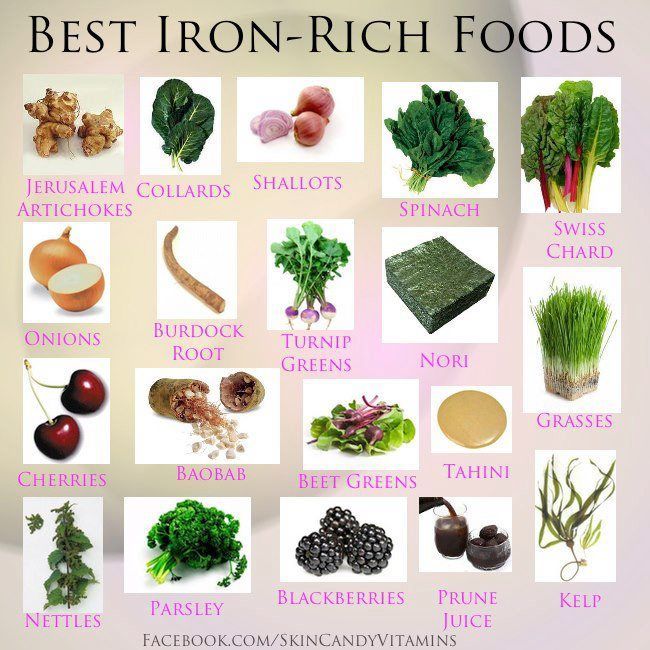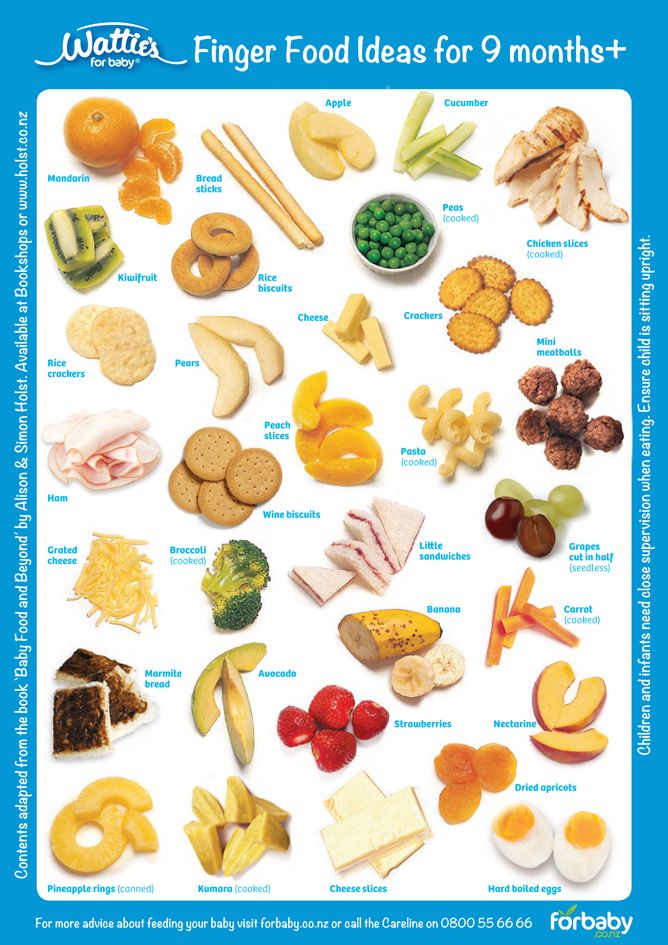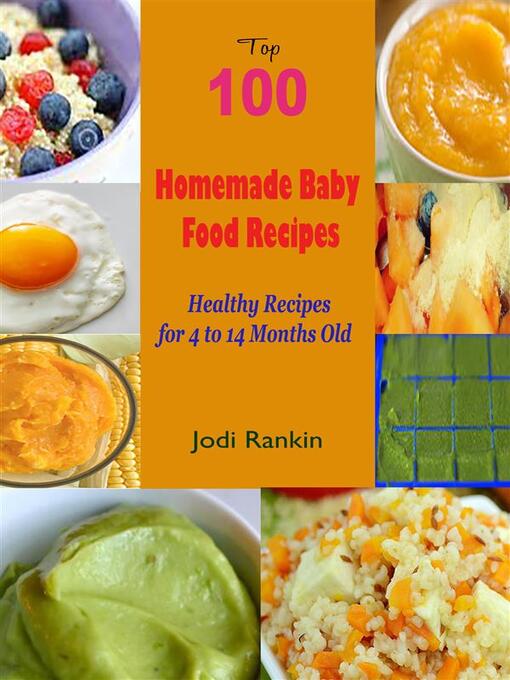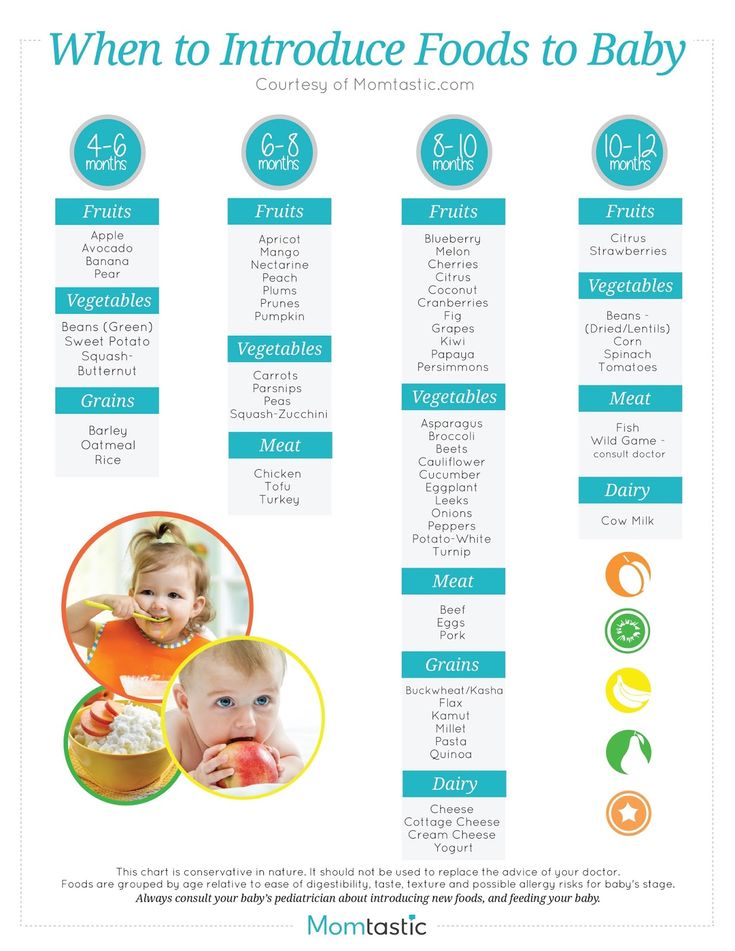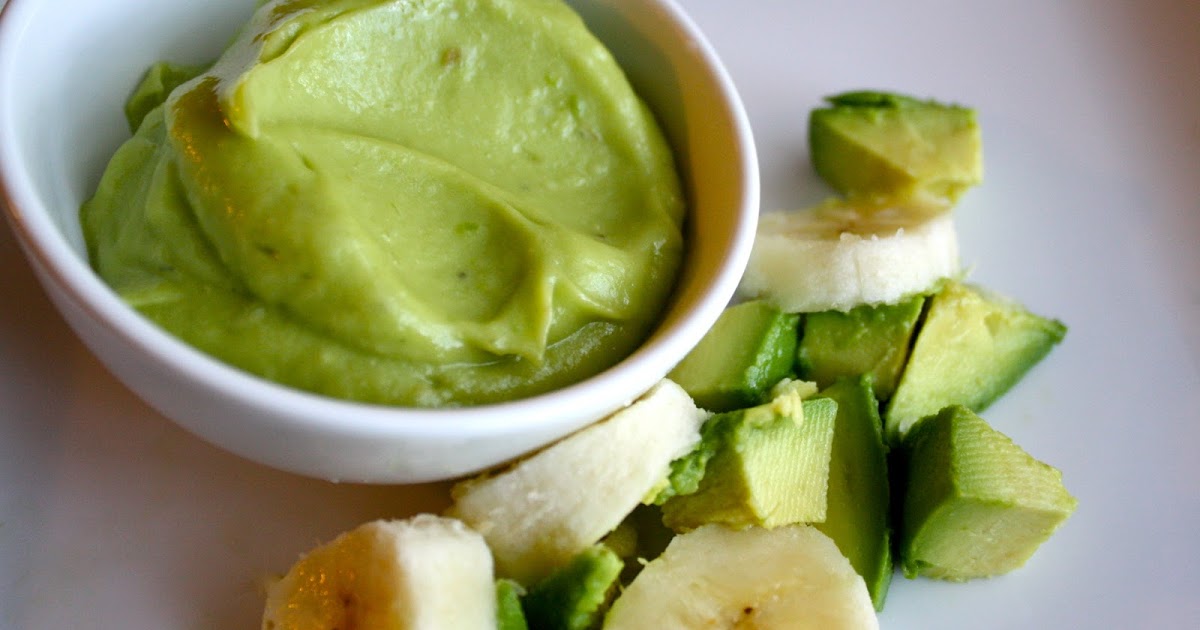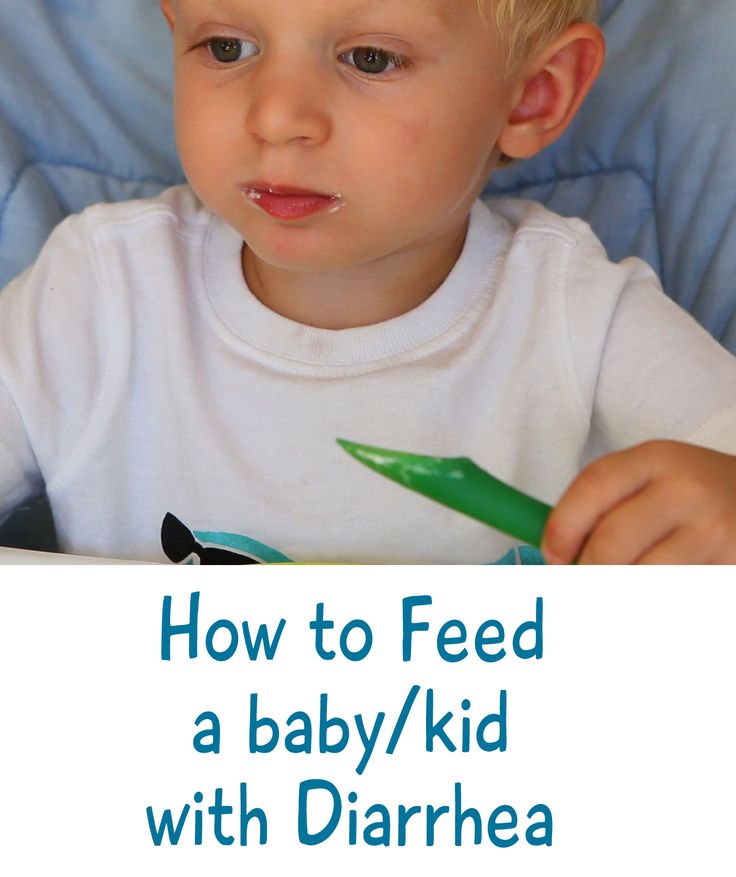Iron rich vegetarian baby food
Parents, These Are The Best Plant-Based Iron Rich Foods for Babies and
Quick Take
We know babies and toddlers need adequate iron to thrive, but parents are still often left with questions about iron for babies, especially if they’re trying to feed their kids mostly plant-based foods. How much iron do small children need? When should parents start incorporating iron-rich foods in their children’s diets? Can you get enough iron on a plant-based diet? And if so, what are the best plant-based sources of iron rich food for babies and toddlers? We cover all of this and more so you can rest easy about meeting your kiddo’s iron needs.
Before We Begin: Make Mealtime Easy with Healthy Kid-Friendly Meals, Delivered (No Cooking Required!)
We've all heard that regularly eating dinner together will improve your family’s health and happiness (even your kiddo’s grades). But let’s get real — life is busy and finding time to plan and cook healthy meals every day isn’t easy. Mama's got your back with this kid-friendly and family-sized bundle. Prepared and healthy meals to heat and eat for your family.
Order MamaSezz Family Bundle now.
On This Page
Why Do You Need to Focus on Iron Rich Food for Babies and Toddlers
How Much Iron Do Babies and Toddlers Need?
Can Kids Get Enough Iron Rich Food From Plants (Plus the Difference Between Animal and Plant Iron?
Top Plant-Based Sources of Iron Rich Food for Babies and Toddlers
Key Takeaways
Why Do You Need to Focus on Iron Rich Food for Babies and Toddlers
OK, well it’s not just babies and toddlers who need iron. Iron is an important part of any diet, at any age. But iron for babies is especially important for those growing bodies.
Iron is an essential mineral that our body uses to support its natural functions. Specifically, it’s a key component in hemoglobin, the molecule that red blood cells use to transport oxygen throughout your body.
If you don’t have enough iron, then your body can't make enough healthy oxygen-carrying red blood cells. This leads to iron deficiency, which for children can look like:
- Pale skin
- Fatigue
- Cold hands and feet
- Slowed growth and development
- Poor appetite
- Abnormally rapid breathing
- Behavioral problems
- Frequent infections
- Pica, a condition in which your child craves non-food items like dust, chalk, etc.
The good news is, most healthy full-term babies are born with enough iron stores in their bodies to last typically about six months. Breastfed babies do better with iron absorption than formula-fed babies for a few reasons. First, the Vitamin C and lactose levels in breastmilk aid in iron absorption. And second, cow’s milk can irritate the intestinal lining, which results in a small amount of bleeding and the loss of iron whereas breastfed babies don’t lose iron through their bowels.
Around 6 months of age, breastfed or not, the iron stores babies are born with typically begin to dwindle, which is why it’s often recommended for parents to focus on iron rich foods for babies when introducing solids (iron deficiency anemia is most common in children aged 9 months to 24 months).
Note: check with your healthcare provider if you’re worried about your child’s iron levels. It is not often recommended you introduce solids before six months of age.
How Much Iron Do Babies and Toddlers Need?
While iron deficiency certainly isn’t good for growing minds and bodies, meeting the iron needs of babies and toddlers isn’t too difficult.
Iron needs for small children are as follows:
- Infants 6–12 months = 11 milligrams of iron a day
- Toddlers 1–3 years = 7 milligrams of iron each day
Can Kids Get Enough Iron from Plant-Based Foods?
There’s a common misconception that in order to get adequate iron from food, we must eat red meat. While yes, steak and other meats are rich sources of iron, there are plenty of plant-based sources, too. Though animal and plant-based sources of iron do differ.
Heme vs. Non-Heme Iron — What’s the Difference?
Heme iron is found in animal products, like meat and poultry. Non-heme iron is found in plant-based foods, like legumes and vegetables. Non-heme plant-based iron makes up about 85% - 90% of the iron intakes in Western populations.
Non-heme iron is found in plant-based foods, like legumes and vegetables. Non-heme plant-based iron makes up about 85% - 90% of the iron intakes in Western populations.
Heme iron has a more efficient absorption rate in the body, which is why people often think that meat or other animal sources of iron are superior to plant-based sources. But the absorption rate doesn’t tell the whole story.
First, meat consumption is linked to increased risk of metabolic syndrome, coronary heart disease, atherosclerosis, stroke, type 2 diabetes, Alzheimer’s disease, Parkinson’s disease, arthritis, and cancer.
Second, you can increase your child’s absorption of iron simply by serving more Vitamin C-rich foods alongside their iron-rich plant-based foods. 100 mg of Vitamin C (one large orange) alongside your little one’s plant-based iron can increase absorption by 67 percent.
There is also some evidence suggesting vegetarian and vegan children need to consume 1.8 times as much iron as omnivore children, though studies show that vegan children are no more likely to be iron-deficient than any other children.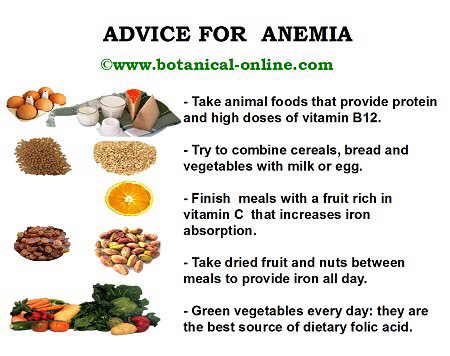
Like so many things in nutrition, we tend to get bogged down in the details (especially if we’re new parents. The good news is, when it comes to iron for babies, simply offering iron rich foods 2-3 times a day will typically ensure your child is getting all the iron they need.
But what iron rich foods for babies are best if you’re going the plant-based route?
Top Plant-Based Sources of Iron Rich Food for Babies and Toddlers
We asked Registered Dietitian Nutritionist and Licensed Dietitian, Addie Dulaney Majnaric, about the best sources of iron in plants.
Here are some of the best plant-based sources of iron rich food for babies and toddlers, plus our top tips for getting your kiddos to actually eat them:
1. Legumes and Beans
- You can serve beans as a finger food once your baby develops the pincer grasp
- Whip up some oil-free hummus and serve it on whole grain toast or with bell pepper strips (for older toddlers)
- No time to cook? Order MamaSezz Millie’s Chili and just heat and eat.
 It’s the perfect vegan chili for young kids because it’s not spicy. Pro tip for parents with babies and younger toddlers: Strain a big scoop of MamaSezz Millie’s Chili before serving your child to make it into finger food.
It’s the perfect vegan chili for young kids because it’s not spicy. Pro tip for parents with babies and younger toddlers: Strain a big scoop of MamaSezz Millie’s Chili before serving your child to make it into finger food.
2. Tofu
- Your kid doesn’t like tofu? This is the secret to making tofu taste really, really good.
- Skip the chicken nuggets and make tofu nuggets instead. Your little one won’t know the difference and this oil-free healthy vegan tofu nugget recipe from Sarah’s Vegan Guide is super easy to make.
- No time to cook? Order MamaSezz Salt-Free Ricotta Style Mushroom and Tomato Bake and add it to your favorite whole grain or gluten-free pasta for a kid-friendly dinner. Pro tip for parents with babies and young toddlers: choose short-cut pasta like elbows, ziti, and rotini to make it easier for those little fingers to pick up.
3. Rolled Oats
- You don’t need to buy iron-fortified oats; regular oats (whether quick, rolled, or steel cut) are a great iron rich food for kids as is.

- Try these chewy oatmeal banana pancakes for an iron rich food for toddlers. They’re refined sugar-free and super easy to whip up. You can even make a big batch to freeze then reheat pancakes in the toaster, air fryer, or microwave as needed throughout the week. Score!
- No time to cook? Order MamaSezz Veggie Loaf for a kid-friendly meal that takes 3 minutes to prepare. Top with your favorite refined sugar-free ketchup to make it extra toddler approved. Pro tip for parents with babies and younger toddlers: chop MamaSezz Veggie Loaf into cubes for easy self feeding.
4. Quinoa
- Switch up your kiddo’s morning oats with a big hearty bowl of this cinnamon quinoa.
- Keep things simple with this no-recipe lunch or dinner. Simply make quinoa according to package instructions, let cool, and serve with steamed or roasted veggies for a baby-approved stir-fry!
- No time to cook? Order MamaSezz Lentil Dhal With Quinoa and just heat and serve.
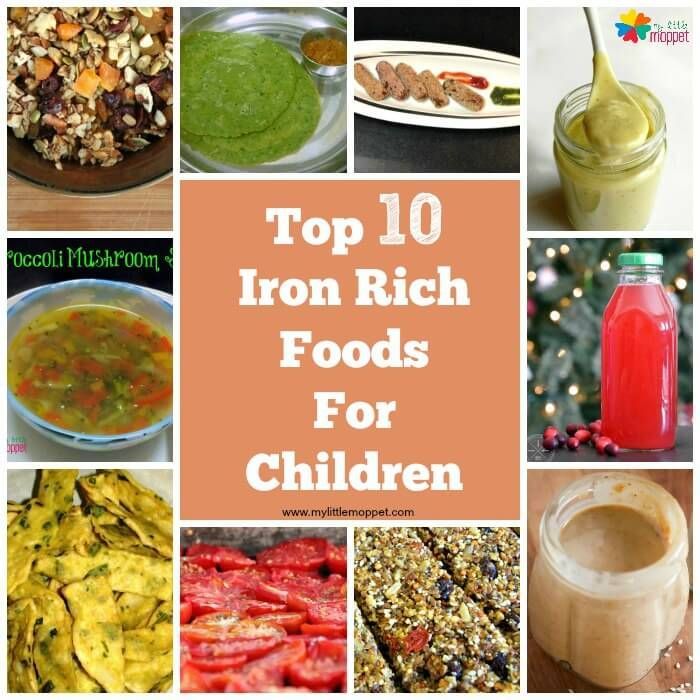 While traditionally dhal is pretty spicy, our take is fairly mild though did you know pediatric feeding experts recommend babies and toddlers are introduced to multitude of subtle spices and flavors? In fact, exposing your babies to different types of foods can help you avoid having a picky eater later (and help them really enjoy eating!). Just start small!
While traditionally dhal is pretty spicy, our take is fairly mild though did you know pediatric feeding experts recommend babies and toddlers are introduced to multitude of subtle spices and flavors? In fact, exposing your babies to different types of foods can help you avoid having a picky eater later (and help them really enjoy eating!). Just start small!
5. Leafy Green Vegetables (Spinach, Kale, Broccoli, Brussels Sprouts, Cabbage, Collards)
- Make green veggies fun by spreading this creamy green avocado hummus on your child’s whole grain toast.
- Need to sneak greens past your picky eater? Blend leafy greens into your favorite marinara sauce for pasta night and they’ll be none the wiser. Bonus: the tomatoes are a Vitamin C rich food which means they’ll help your child absorb the iron from the leafy greens.
- No time to cook? Order MamaSezz Creamy Broccoli Soup for a comforting lunch the whole family can enjoy.
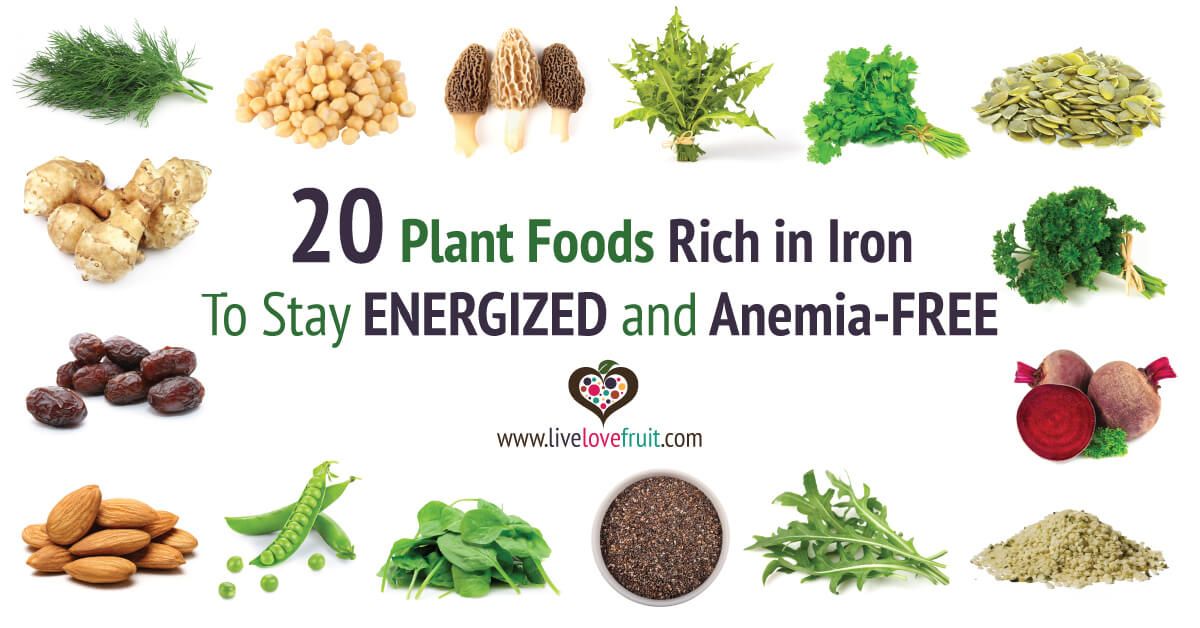
6. Nuts and Seeds
- Whole nuts and seeds are considered a choking hazard until the age of four so choose nut and seed butters until then.
- Nuts are a common allergy food so check with your pediatrician on how and when to introduce these to your child, though the standard recommendation is around 6 months.
- Sick of serving peanut butter toast? Order MamaSezz Mama’s Mac for a kid-friendly dinner you don’t have to cook. Made with our delicious cashew cream sauce, it’s the ultimate vegan mac and cheese and our customers tell us it’s even a win for picky eaters.
Key Takeaways
- Whether you’re a full on vegan family or simply trying to feed your kiddos more plant-based foods, you can rest assured that there are great plant-based iron rich foods for kids to choose from, including: beans and legumes, tofu, rolled oats, quinoa, dark leafy greens, nuts and seeds.
- Non-heme sources of iron (AKA plant-based sources of iron) are better absorbed when paired with Vitamin C rich foods.

- A good rule of thumb to ensure your baby or toddler gets enough iron: offer iron-rich food 2-3 times a day to your child.
- While vegan children don’t appear to be more anemic than any other children, it is sometimes recommended for parents to feed vegetarian and vegan children 1.8 times the iron RDA for kids their age.
- Top plant based sources of iron rich food for babies and toddlers include legumes and beans, tofu, rolled oats, quinoa, leafy dark greens, nuts and seeds.
- No time to prepare iron rich food for babies? Make mealtime easy with the MamaSezz Family Bundle. Ready-made and healthy plant-based meals with all the nutrients your little one needs to thrive. Delivered right to your door, and all you have to do is heat and eat.
By Ali Brown
Ali is a mom, wife, and nutrition and lifestyle writer and editor. She has her Plant-Based Nutrition Certificate from the T. Colin Campbell Center for Nutrition Studies.
Best Iron Rich Foods for Babies and Toddlers (50+ recipes)
Regardless of which feeding approach you choose, purees or baby led weaning, introducing iron rich foods from the start is extremely important. Here is a list of top foods and recipes for babies and toddlers.
Jump to:- Best Sources of Iron for Babies and Toddlers
- Iron for babies and toddlers
- How much iron does a baby or toddler need?
- Signs of iron deficiency anemia
- Top Tips to help increase iron level
- Best Vitamin C Rich foods
- Iron-Rich Food Ideas for Vegetarian Babies and Toddlers
- Frequently Asked Questions
- Iron-rich recipes for Babies and Toddlers
- 3 Month Meal Plan for Babies
Best Sources of Iron for Babies and Toddlers
There are two types of iron, heme (from animal products) and non-heme (found in plant foods).
While heme iron is better absorbed by the body than non-heme iron, that doesn't mean you should focus all your efforts on serving meat to your child.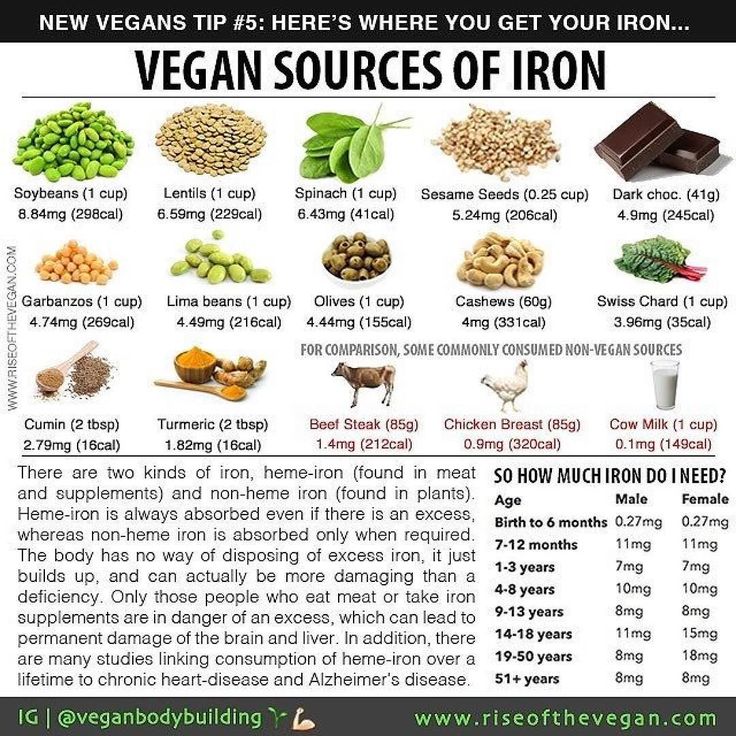
Always aim for variety and be sure to offer an iron-rich food at every meal! There are plenty of choices as listed here that will help meet your baby's needs.
Heme IronClick on any of the links to learn exactly how to cook and serve the specific food to your baby!
- Red meat (beef, lamb, pork, venison. Chicken liver and other organ meats contain the highest)
- Chicken
- Turkey
- Eggs
- Seafood (salmon, sardines)
Non heme Iron
- Lentils
- Beans (particularly white, chickpeas, kidney beans)
- Tofu
- Nuts and seeds (particularly almonds, cashews, pine nuts, hemp, flax, sesame, and pumpkin seeds)
- Dark green leafy vegetables
- Whole grains - (particularly amaranth, spelt, oats, and quinoa)
- Fortified baby cereals
Iron-Rich Vegetables
- Dark leafy greens – Dandelion, swiss chard, collard, kale, spinach, beet greens
- Baked potato
- Asparagus
- Broccoli
- Cabbage
- Peas
- Mushrooms
- Tomato paste - raw tomatoes contain very little iron.
 But when dried or concentrated, they are a great source!
But when dried or concentrated, they are a great source!
Iron-Rich Fruits
Generally, fruits are not good sources. These are the top choices:
- Prune juice
- Dried fruits (particularly apricots, dates, figs, raisins)
But a lot of fruits contain vitamin C, which will aid in iron absorption.
Iron for babies and toddlers
Iron is essential for producing red blood cells that carry oxygen from the lungs to all parts of the body. It’s also important for optimal brain development.
Iron is also one of the primary reasons that we start solid foods when we do. Babies are born with iron stores built up during their time in the womb. And this is why moms need to maintain a healthy iron status during pregnancy.
But by 6 months of age, it becomes depleted. At the same time, their iron needs increase drastically to support their rapid growth and development.
Inadequate iron intake in infanthood and childhood can lead to cognitive, including decreased attention and memory, as well as behavioral impairment, such as delayed attention, social withdrawal, and learning difficulties.
Top foods for 8 month old baby
How much iron does a baby or toddler need?
From the American Academy of Pediatrics:
- Birth-6 months: .25 mg
- 7-12 months: 11 mg
- 1-3 years: 7 mg. While there's so much focus on iron for babies, toddlers deserve the same degree of attention. Research shows that this age group have the lowest daily iron intake of any age group across the lifespan.
To give you context:
- 3 ounces steak: 2.5 mg of iron
- ¼ cup cannellini beans: 2 mg
- ½ of egg: .5 mg
- 3 tablespoons fortified infant oat cereal: 5 mg
- 3 ounces chicken liver: 9.9 mg
- 3 ounces salmon: .8 mg
- ¼ cup cooked spinach: 2 mg
- 2 ounces chickpea pasta: 3 mg
- ¼ cup raw tofu: 1.6 mg
- 1 teaspoon hemp seeds: .32mg
- ¼ cup cooked lentils: 2 mg
- 2 tbs peanut butter: .6 mg
Now please don’t start calculating and keeping track of how much your baby is getting daily. Nor stressing about what inhibits iron and what doesn’t.
Nor stressing about what inhibits iron and what doesn’t.
This will just drive you crazy and lead to lots of anxieties and worries, especially if you are doing baby led weaning and following your baby’s lead.
And don't worry! Your baby won't need 11 mg of iron right away. It is not like once your baby hits 6 months, their iron reserve is completely depleted. It's a gradual process.
What I encourage you to do, once again, is focus on including an iron-rich food at every meal! All those little bites will add up. And as they have more practice with eating, they will be able to meet their iron needs.
- Fatigue, weakness
- Slow weight gain
- Pale skin
- Irritability (cranky, fussy)
- Shortness of breath
- Cold hands or feet
- No appetite
- For toddlers: difficulty in concentration, shorter attention span
Best First Foods for babies
Top Tips to help increase iron level
- Iron from animal products (heme iron) is absorbed better in the body.
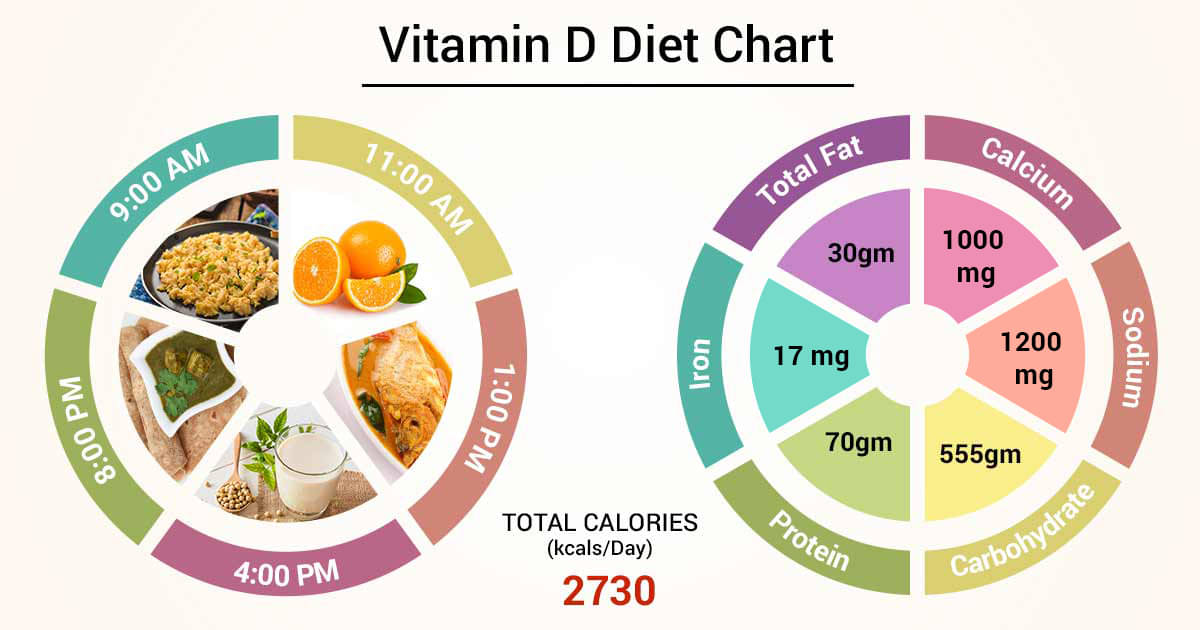
- Be sure to combine plant-based iron (non-heme iron) with vitamin-C rich foods.
- It’s true that calcium inhibits the absorption of iron, but there's no need to go out of your way to make sure you absolutely don’t serve calcium-containing foods with iron-rich foods. There are so many factors that affect iron absorption. Calcium is just one of them. What I do recommend is to not serve both at every single meal. .
- For toddlers, don't serve too much milk.
- Choose fortified products, such as fortified infant cereal or bread.
- Use a cast iron pan: cooking foods in cast iron cookware may increase the iron content of meals by up to 16%
Best Vitamin C Rich foods
- Oranges
- Grapefruit
- Kiwi
- Berries
- Cantaloupe
- Mango
- Pineapple
- Plums
- Tomatoes
- Bell peppers
- Broccoli
- Brussels sprouts
- Kale
- Peas
- Squash
Iron-Rich Food Ideas for Vegetarian Babies and Toddlers
Again, ALWAYS pair non-heme iron sources with Vitamin C rich food. I can't emphasize this enough!
I can't emphasize this enough!
- Pumpkin seed hummus spread on whole grain toast with strawberries
- Iron-rich sauce tossed with legume-based pasta
- Oatmeal with peanut butter, hemp seeds, and mango puree
- Mashed beans with finely chopped kale and quinoa
- Tofu with broccoli and tomato
- Hummus spread on bell pepper strips
- Mashed edamame with sweet potatoes (as a finger food or mashed)
- Lentils with finely chopped broccoli, tahini, garlic powder
- Infant oatmeal cereal with ground flax seeds and sunflower seed butter
Frequently Asked Questions
Does your baby need an iron supplement?
As you can see, the recommended intake is really high relative to how much food they’re likely to eat. If you've decided to do baby led weaning, you may be especially concerned as not much food will actually make it into your baby's belly during the first days, weeks of starting solids.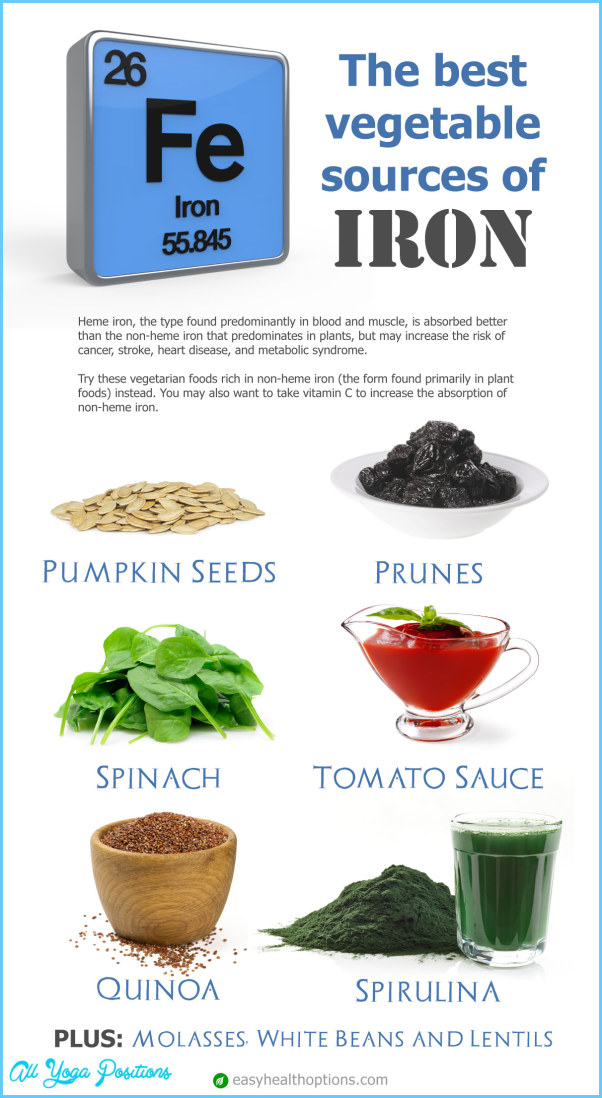
As long as you're offering an iron-rich source at every meal along with breast milk and/or infant formula, your baby will likely continue to meet their needs as they wean.
However, it's always best to consult with your healthcare provider, especially if your baby is not developmentally ready to start solids at around 6 months.
Routinely, hemoglobin levels are checked starting at 12 months, usually. But you can always ask to have it checked earlier and supplement accordingly.
What you don't want to do is automatically supplement on your own as it can cause more harm than good, if not necessary. The same goes for toddlers. If they've become really fussy and rejects most or all iron-rich foods, then bring this up to your doctor.
Can babies get enough iron from a vegetarian diet?
Facts: Iron from heme found in animal sources is absorbed better than iron from non-heme or plant sources. There are also many compounds found in plant foods, such as phytates and tannins, that reduce iron absorption.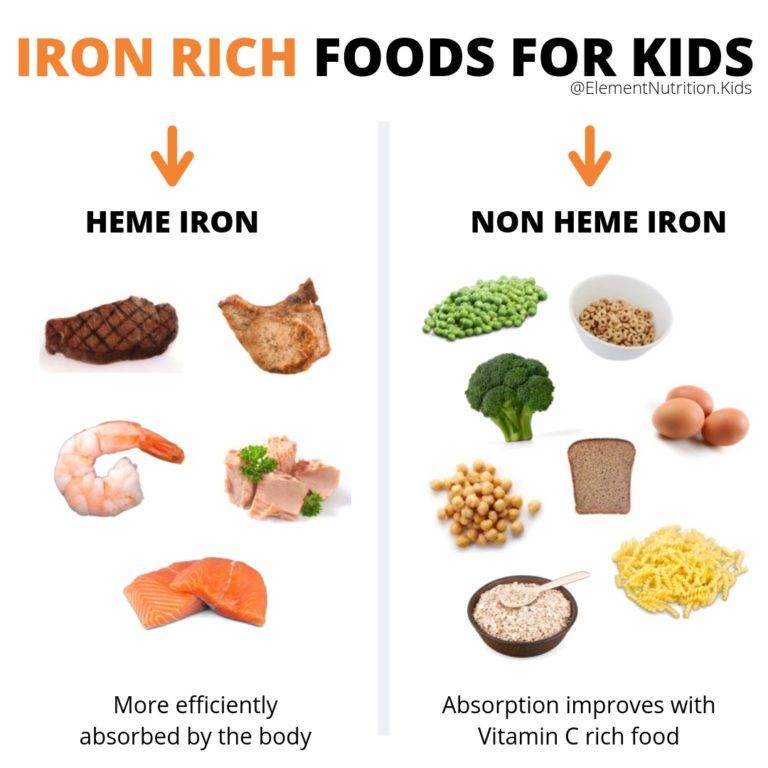
Therefore, the recommended dietary intake for iron for vegetarians is 1.8 times higher than for meat eaters.
Knowing this, If your family is a vegetarian, you may be concerned that your baby is at an even greater risk for iron deficiency.
However, the good news is there are so many great food sources, and with some planning, plant-based diets can be adequate in iron. Check out the tips section above.
Should infant rice cereal be a baby's first food?
Perhaps you were recommended by your doctor, family, or friends to start with iron-fortified rice cereal. This is outdated advice. While it is suitable, your baby does NOT need to start with rice cereal.
It's also high in arsenic, which you want to try to limit as much as possible. That’s not to say you shouldn’t give your baby rice at all, as it is a main staple in so many cultures, but you do want to be mindful.
Having said this, fortified infant cereal is a great option to help meet your baby's nutritional needs. Look for ones made with whole grains, like oat, barley, quinoa, and buckwheat.
Look for ones made with whole grains, like oat, barley, quinoa, and buckwheat.
Iron-rich recipes for Babies and Toddlers
Breakfast/Snacks
Easy Quinoa Baby Cereal (4 Ways)
Making homemade baby cereal or porridge is SO easy and inexpensive! If you've only been serving rice or oat-based cereals, give this iron-rich quinoa version a try!
Get the recipe
Homemade Baby Oatmeal
Learn how to cook the perfect oatmeal for baby. It's easy, fast, and loaded with vegetables! Serve as is or shape into fingers or balls, baby led weaning style!
Get the recipe
Healthy Pumpkin Oatmeal Bars
These healthy oatmeal pumpkin bars are high in protein and low in sugar. A healthy no fuss breakfast or snack for your baby and toddler.
Get the recipe
3 Ingredient Baby Cookies
3 ingredients are all you need to make these soft and delicious vegan banana oatmeal cookies.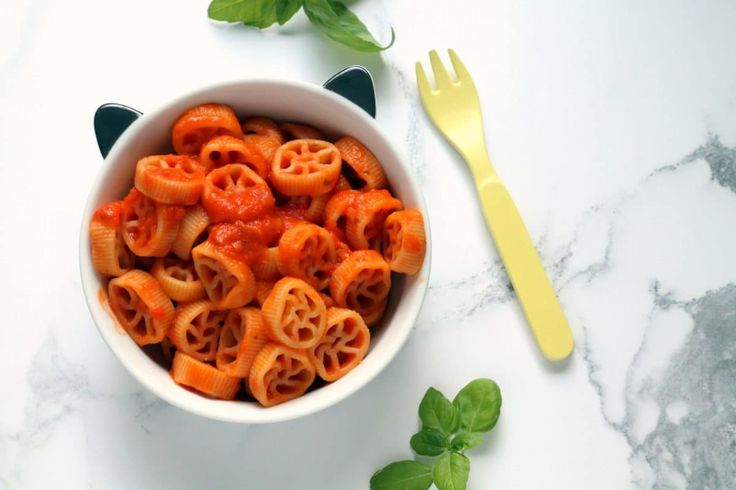 They are the perfect breakfast or snack for babies!
They are the perfect breakfast or snack for babies!
Get the recipe
2 minute egg oatmeal
These microwave egg oatmeals for babies, toddlers, kids, (and adults!) are SUPER easy to make and come together in 2 minutes! Enjoy as a filling protein and fiber-rich breakfast or snack.
Get the recipe
Savory Baked Oatmeal with Vegetables
This savory baked oatmeal is so easy to make and a great way to enjoy vegetables for breakfast! Perfect for baby led weaning and lunchboxes.
Get the recipe
Pumpkin Seed Spinach Hummus
this spinach hummus with pumpkin seeds instead of tahini is a healthy snack or meal for babies and toddlers. It is so versatile and here are some ways to serve it to your family.
Get the recipe
Vegan vegetable quinoa muffins
Made with healthy ingredients like broccoli, carrots, and quinoa, these egg and dairy-free vegetable muffins with quinoa are perfect for baby led weaning and school lunchboxes.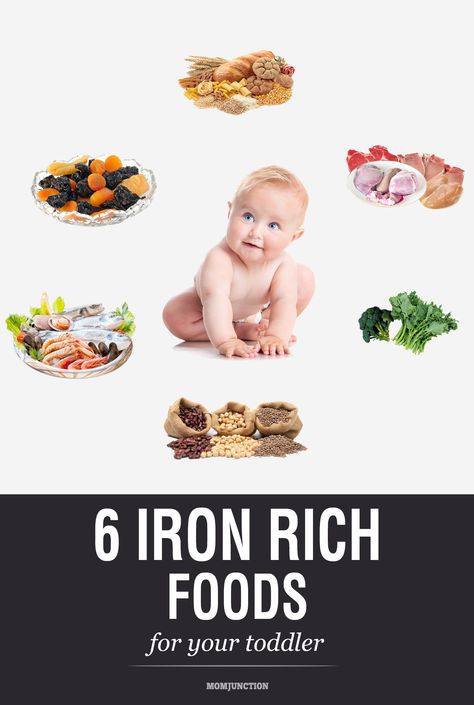
Get the recipe
Chickpea Patties (gluten free)
These flavorful chickpea patties with quinoa are easy to make with simple pantry staples. Shape them into patties or even nuggets
Get the recipe
Vegetable Omelette
Nutritious and easy to make, this baby-friendly omelette made with whatever veggies you have on hand is the perfect breakfast/snack for babies and toddlers!
Get the recipe
Healthy Sweet Potato Cookies
These super moist sweet potato cakes made with just 5 simple ingredients, including chickpeas, oats, and chia seeds, are perfect for babies and toddlers.
Get the recipe
Healthy Beet Muffins for Babies
Made entirely with healthy ingredients, like beans, peanut butter, and no added sugar, these blender muffins can be enjoyed as breakfast, snack, or added to lunchboxes!
Get the recipe
Moist Spinach Muffins
These healthy spinach muffins with banana are fluffy and moist in texture and packed with nutrition. They are perfect for babies and kids.
They are perfect for babies and kids.
Get the recipe
Healthy Pumpkin Banana Muffins
These healthy pumpkin banana muffins are super moist and have the perfect balance of natural sweetness and warm fall flavors
Get the recipe
Beetroot Dip with chickpeas
4 nutritious ingredients, a food processor/blender, and dippers are all you need for this smooth, creamy, and vibrant beetroot dip for babies and toddlers!
Get the recipe
Tofu Veggie Scramble
Vegetarian breakfast of champions - tofu veggie scramble! It's a hearty and delicious plant-based alternative to scrambled eggs that your family can enjoy for breakfast, lunch, or dinner!
Get the recipe
Overnight Oats or Quinoa
These super easy and healthy sweet overnight oats or quinoa are the perfect make-ahead breakfast or snack for the whole family. Feel free to customize with your favorite add-ins and toppings!
Feel free to customize with your favorite add-ins and toppings!
Get the recipe
Egg-Free Carrot Lentil Bars
Broccoli White Bean Pesto
This nut-free broccoli white bean pesto packs in so many nutrients with minimal effort! It’s a great way to incorporate veggies and important nutrients, like iron, into your baby and toddler’s diet.
Get the recipe
Salmon Quiche - Baby Led Weaning
Healthy crustless salmon quiche that the whole family can enjoy, including babies 6 months and older! Perfect for breakfast, snack, and lunchboxes.
Get the recipe
Mexican Lentil Muffins
Looking for a healthy savory vegetable muffin for kids? These Mexican lentil muffins are moist and packed with essential nutrients that babies and toddlers need.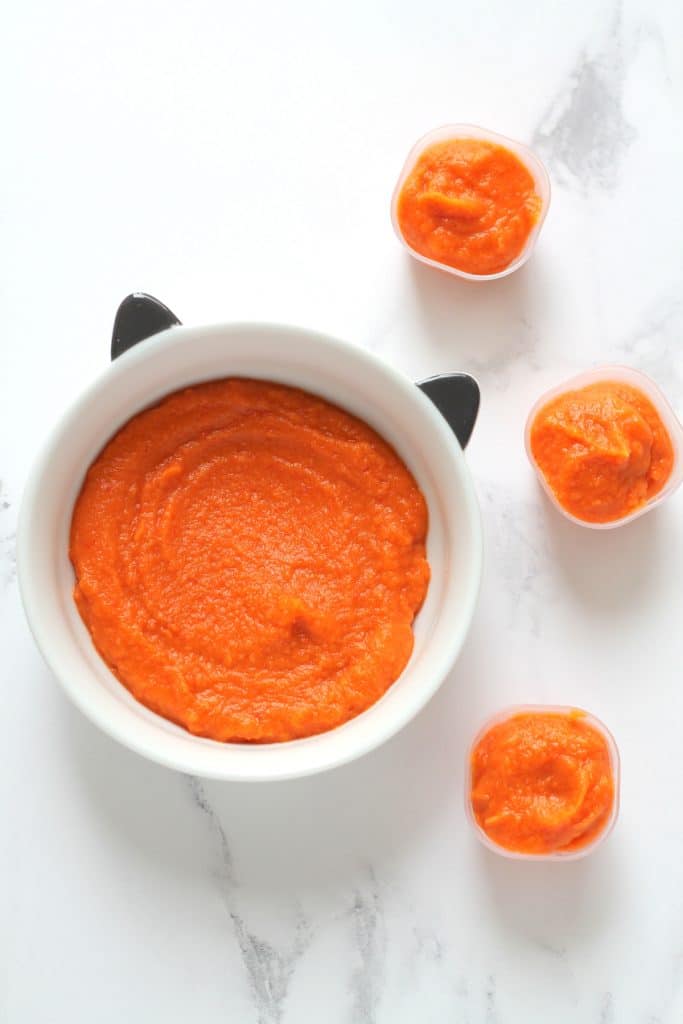
Get the recipe
Lunch/Dinner Ideas (with meat)
rice porridge for babies
Super easy to make, this beef and vegetable rice porridge for babies is easy-to-digest, nutritious, and suitable for 6 months and up.
Get the recipe
Healthy Beef Meatballs
These healthy beef meatballs are made with just 5 simple ingredients and are egg free and dairy free. Tender and flavorful, these are perfect for babies and kids of all ages!
Get the recipe
Baked Quinoa and Mushroom Beef Meatballs
baked meatballs made with ground beef, mushroom, and quinoa. It's the ultimate comfort food that can be enjoyed as is or with pasta, vegetables, salads
Get the recipe
How to Cook Chicken for Babies
Introduce chicken to your baby with confidence with these cooking tips and recipes! Whether you are doing purees, baby led weaning, or both, chicken is a wonderful first food, loaded with iron.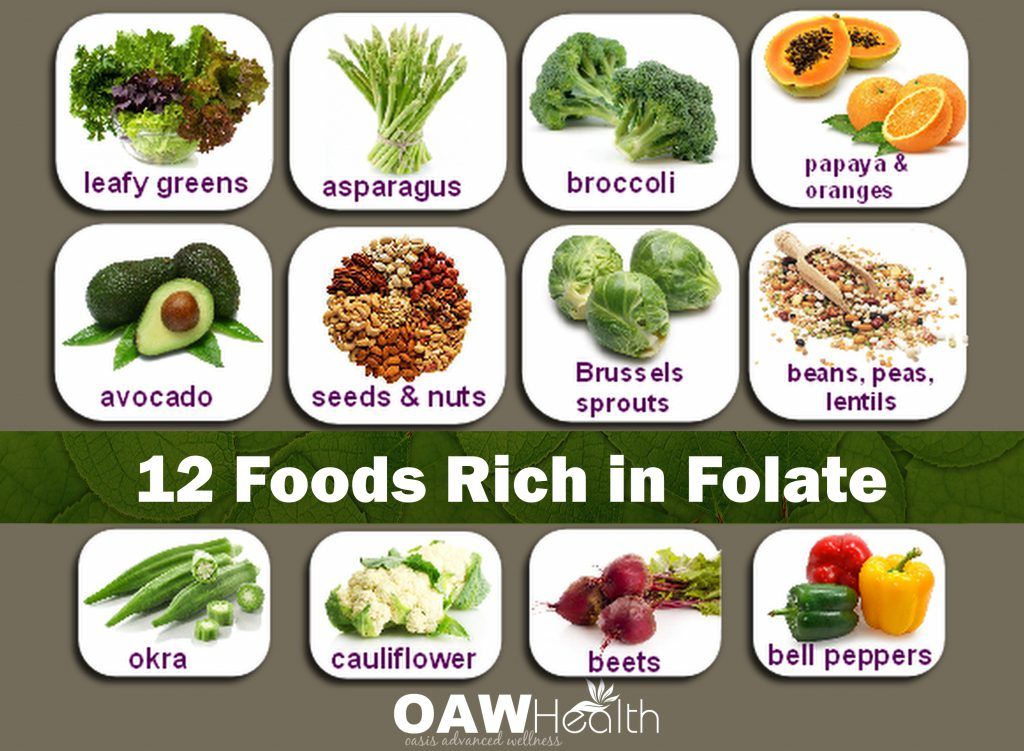
Get the recipe
How to Roast a Turkey Breast
Learn how to roast a turkey breast perfectly for a holiday meal or everyday dinner. Crispy golden brown skin, juicy and flavorful, it's a guaranteed crowd pleaser.
Get the recipe
Turkey Meatballs with rice
These oven baked kid-friendly turkey and rice meatballs are the perfect iron-rich finger food for your baby, children of all ages, and adults!
Get the recipe
Kid-friendly Turkey Beet Meatballs
These oven-baked turkey beet meatballs are quick and easy to prepare, healthy, and most importantly baby and toddler approved!
Get the recipe
Mini Shepherd's Pie Muffins
A quick and easy, baby and kid-friendly twist on an Irish classic comfort food, these mini shepherd pie muffins are filled with beef, vegetables and topped with creamy mashed potatoes
Get the recipe
Pressure Cooker Steak Fajitas
Super juicy and flavorful, this pressure cooker steak fajitas recipe for babies and kids is perfect for busy weeknights.
Get the recipe
One Pot Cabbage Lasagna
EASY and healthy no noodle lasagna made in one pot and ready in 30 minutes! This cabbage lasagna is a hearty, oh so comforting meal that the whole family, including your baby, can enjoy together.
Get the recipe
Baby-Friendly Korean Bulgogi
This baby-friendly Korean bulgogi is easy to make and perfect for your baby, toddler, and family! If you’re looking for a baby led weaning recipe and healthy kid friendly meal on a budget, make this today!
Get the recipe
Easy Bolognese with Vegetables
This kid-friendly veggie-loaded meat sauce with ground beef and medley of vegetables is hearty, filling, and nutritious!
Get the recipe
Orange Sesame Chicken with Vegetables
a healthy Asian chicken recipe that’s low in sodium, this skillet orange sesame chicken with vegetables is perfect for babies and the family.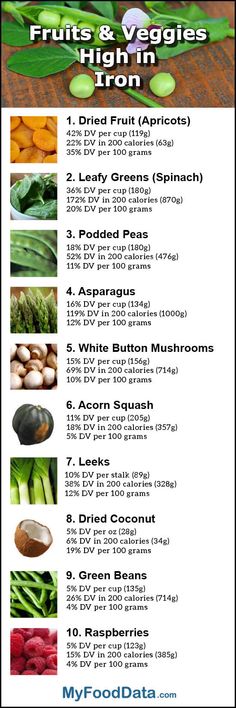
Get the recipe
Low-Sodium Moo Goo Gai Pan
Chinese mushroom chicken stir-fry dish loaded with vegetables! This version is made baby and toddler-friendly with less sodium but plenty flavorful for the entire family to enjoy!
Get the recipe
Vegetable Beef Soup with Cabbage
This vegetable beef soup with cabbage is a healthy comfort meal and makes for a great way to incorporate more vegetables into your baby or kid’s diet.
Get the recipe
Homemade Hamburger Helper
This baby and kid-friendly homemade hamburger helper is made with ground beef, veggies, and staple pantry items. It's the ultimate one pot comfort meal!
Get the recipe
Healthy Korean Beef and Broccoli Quinoa
If you're in search of an easy, healthy weeknight meal, this Korean ground beef and broccoli quinoa is for you! It tastes like bulgogi and this one pot meal is also baby and toddler-friendly!
Get the recipe
Instant Pot Korean Chicken and Potatoes
If you're in need of a quick and easy weeknight family meal, here's an Instant Pot Korean chicken and potatoes recipe that everyone, including babies, will enjoy!
Get the recipe
Healthy Sweet and Sour Meatball Stir-Fry
A healthy, Asian family-friendly meal that you can get on the table in 30 minutes or less! This easy one-pot sweet and sour meatball stir-fry is baby and kid-friendly!
Get the recipe
Easy Stuffed Shells with Meat
These stuffed shells with ground beef and vegetables are a hearty make ahead dinner or freezer meal for the whole family to enjoy!
Get the recipe
Low Sodium Baked Spaghetti Pie
Baked spaghetti pie with ricotta that's healthy and easy to whip up. It's the perfect comfort food recipe for the entire family!
It's the perfect comfort food recipe for the entire family!
Get the recipe
Instant Pot Peanut Chicken and Broccoli
Another EASY, 30 minute weeknight meal you can enjoy with your baby and kids! This Instant pot chicken and broccoli is also a great way to continue exposing your child to one of the top food allergens, peanuts.
Get the recipe
Chicken Spinach Quinoa Casserole
A baby and kid-friendly comfort meal you don't want to miss! This chicken spinach quinoa casserole with black beans is super easy to make and loaded with iron and protein.
Get the recipe
Lunch/Dinner Ideas (vegetarian)
Cooking Beans for Babies (3 Methods)
Beans are terrific first foods for babies! Here are three methods for cooking dried beans.
Get the recipe
Iron-rich baby pasta
A baby pasta recipe that is loaded with iron and vegetables!
Get the recipe
Carrot and Lentil Soup
This carrot and lentil soup tastes like you spent hours in the kitchen but only takes 30 minutes to make! It's hearty, nutritious, and super flavorful.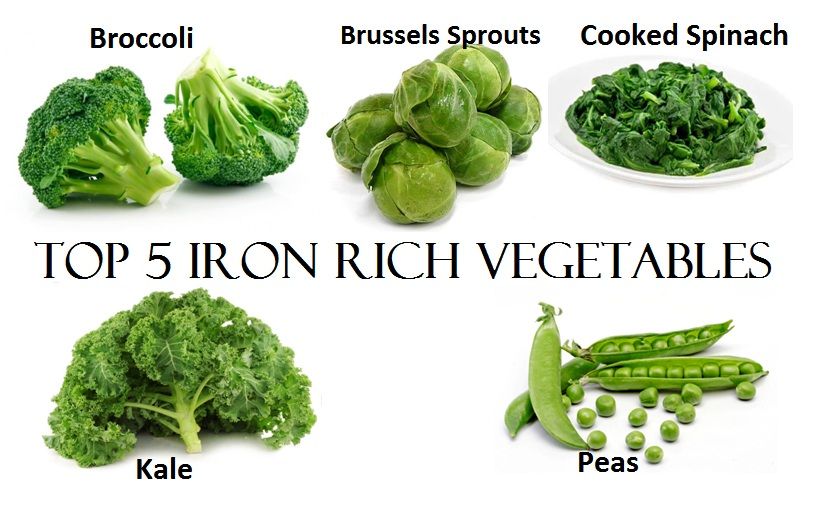
Get the recipe
Slow Cooker Lentil Chili with Chickpeas
Thick and hearty, this vegetarian slow cooker chickpea lentil chili is sure to keep your baby and child happy and nourished. It's also an incredibly iron-rich meal!
Get the recipe
Teriyaki glazed salmon
If you’re looking for a quick and easy salmon recipe for your baby and the entire family, look no further than this teriyaki glazed salmon.
Get the recipe
Vegetarian Sweet Potato Lasagna with Quinoa
This vegetarian sweet potato lasagna with quinoa requires no boiling of noodles and assembly couldn't be easier!
Get the recipe
How to Cook Tofu for Baby Led Weaning
Introduce tofu to your baby with confidence with these cooking tips and recipes! Whether you are doing purees, baby led weaning, or both, tofu is an amazing first food.
Get the recipe
Non-Spicy Korean Tofu Soup
This non-spicy Korean tofu soup, or sundubu jjigae, is warm and comforting, and perfect for the entire family to enjoy, especially babies and toddlers.
Get the recipe
Vegan Creamy Tomato Pasta
Made with simple pantry ingredients, this vegan creamy tomato pasta is perfect for babies and kids with a dairy allergy. It is super versatile and easy to make!
Get the recipe
One Pot Vegetarian Mexican Lentils
Made with pantry staples like lentils, black beans, and sweet potatoes, this one pot vegetarian mexican lentils is the perfect busy weeknight meal.
Get the recipe
Easy baked shrimp cakes
Super juicy and tender, these baked Asian shrimp cakes are baby and kid-friendly! Of course, the adults can enjoy them too.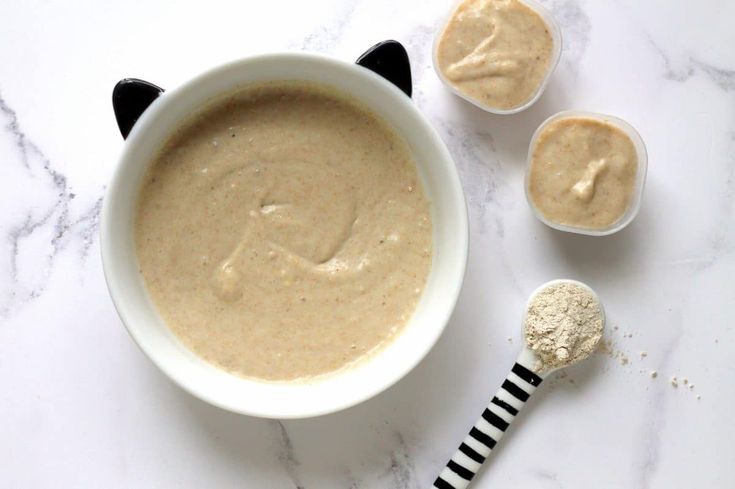
Get the recipe
Easy Salmon Bean Salad
This mayo-free, refreshing yet hearty salmon bean salad couldn’t be easier to make! You can serve with crackers, vegetables, bread, salad, cheese, or whatever you fancy!
Get the recipe
Eggplant Lasagna Roll-Ups
This easy, gluten-free baked eggplant lasagna roll ups with meat is the perfect , healthy comfort food that the entire family will enjoy!
Get the recipe
3 Month Meal Plan for Babies
All the images of baby plates you see in this post are exactly what I served my daughter during our first three months of starting solids.
From speaking to hundreds of parents and caregivers, it was clear that the greatest challenge is how to ensure their baby is getting optimal nutrition while trying to juggle everything and get through the day.
It can feel so overwhelming and frustrating. And that's why I created my 3 month program - Baby Led Feeding Journey.
I'm here to hand you a complete roadmap. Everything all in one place.
There's SO much this program offers but don’t take my word for it. You can find out more here as well as hear from other moms who've gone through it.
Do you want to minimize picky eating and set a solid foundation for a lifetime of healthy eating habits?
Check out this 3 month mastering self-feeding program! It’s the closest thing to me being in your kitchen
from where? Squirrel children Vegetarian children
The food restrictions that exist during fasting are essentially a vegetarian or even vegan diet. Is it possible for children to adhere to it? What rules should parents follow so that the child gets everything necessary for growth and development with food? We offer a modern view on children's vegetarianism and veganism.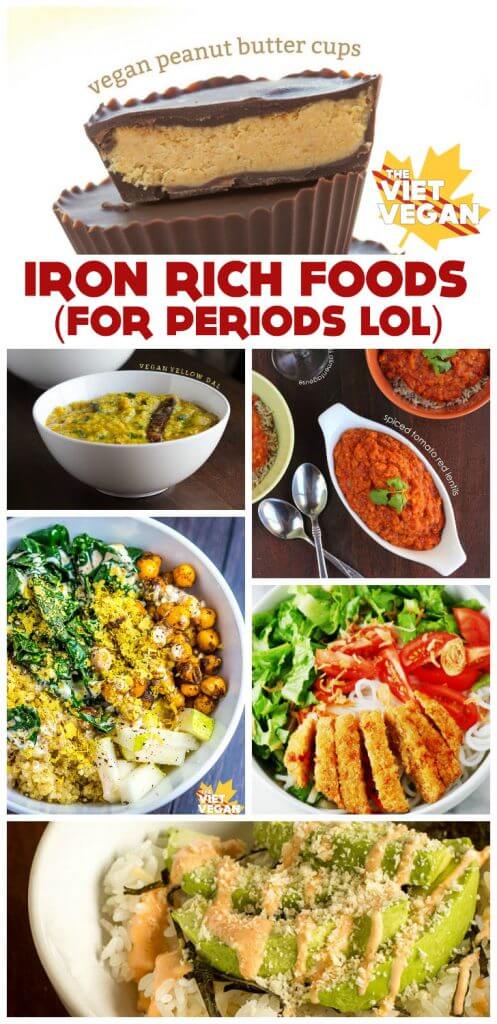
Vegetarian food and the child
The nutrition of a vegetarian child will have to be planned very carefully. The richest and most digestible sources of protein and iron are meat and fish, and you will need to find adequate replacements for them. nine0005
Legumes, nuts, seeds, grains, soy, eggs and dairy are also good sources of protein. But many proteins of plant origin are "inferior", that is, they do not contain the entire set of amino acids that a person needs. Proteins derived from milk, eggs, and quinoa are considered complete proteins. Other foods need to be combined with each other to achieve a balance of amino acids. For example, you can mix beans or lentils with rice, serve pearl barley or spelt with cheese sauce, and add nut butter to yogurt smoothies. It is not necessary to mix proteins at every meal, as long as the whole diet includes various sources of protein. nine0005
Legumes, dried fruits, soybeans, green leafy vegetables, fortified cereals, and eggs are good sources of iron, but for better absorption, they need to be combined with foods rich in vitamin C (virtually any vegetables and fruits).
On a vegetarian diet, your baby will get the right amount of calories, protein and calcium if he eats at least 500 ml of breast milk, formula or other dairy products daily. Of course, when breastfeeding, it's impossible to tell exactly how much milk a baby is eating, so just feed him on demand. nine0005
The vegan diet and the baby
Raising children on a vegan, no-animal diet is a big decision and many authorities do not recommend it. If you are going to transfer your child to such a diet, contact a pediatric nutritionist - he will help you make sure that the child receives all the necessary substances. Professional advice and a carefully thought-out plan of action are simply necessary in this case.
If you are considering switching your baby to a vegan diet, please consider the following:
- Vegan mothers should monitor their diet from conception to help ensure that the baby is getting the nutrition it needs in the womb.
- In a vegan diet, mother's milk is especially important for a child - to a large extent as a source of calcium.
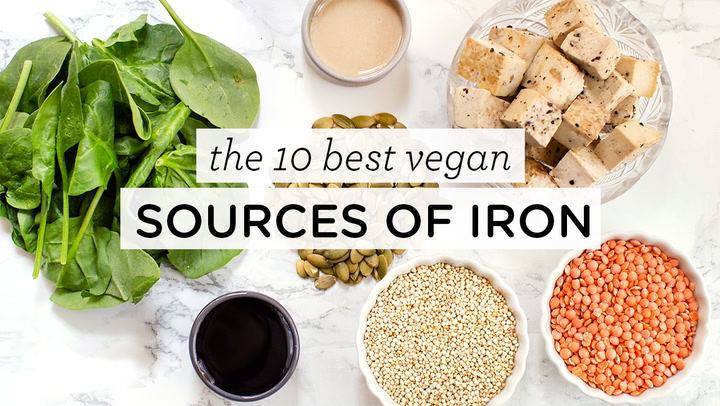 It is better to start using soy milk formulas no earlier than six months. Regular soy milk is too low in fat and may not have enough calcium. Children will benefit from calcium-rich vegetables such as spinach, although they still will not provide the necessary amount of this element. nine0025
It is better to start using soy milk formulas no earlier than six months. Regular soy milk is too low in fat and may not have enough calcium. Children will benefit from calcium-rich vegetables such as spinach, although they still will not provide the necessary amount of this element. nine0025 - A vegan diet often does not provide the amount of calories a growing body needs: it is important to include more fats and oils in the diet.
- Advice regarding plant sources of protein and iron for vegetarians also applies to vegans.
- Essential for growth, vitamin B12 is found naturally only in animal products. You can buy products fortified with this vitamin, such as yeast extract, but they can be too high in salt, so it may be better to use a vitamin supplement. nine0025
- Give your child a vegan-friendly multivitamin supplement.
Salt
All of you probably know that excess salt is harmful. Adults need a little salt, children need even less, and a baby's body can handle only a tiny amount.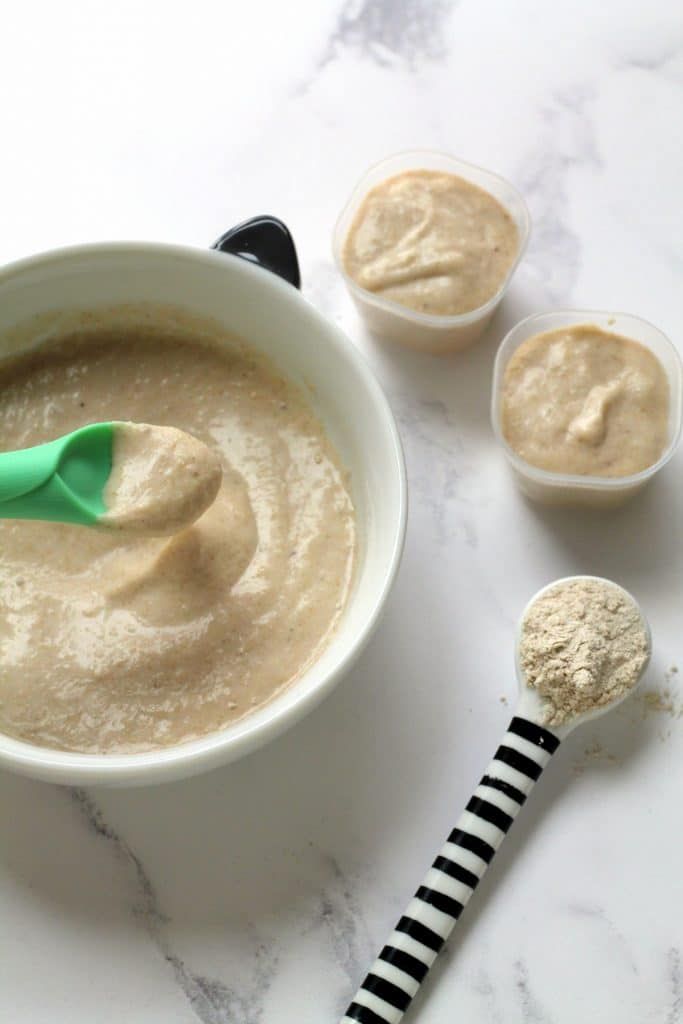 Excess salt is extremely harmful for babies, and even a small amount of it can later lead to high blood pressure, and therefore to heart disease and strokes. Therefore, it is important to carefully monitor the sources of salt in the family diet and observe the measure in everything. nine0005
Excess salt is extremely harmful for babies, and even a small amount of it can later lead to high blood pressure, and therefore to heart disease and strokes. Therefore, it is important to carefully monitor the sources of salt in the family diet and observe the measure in everything. nine0005
Some parents do not salt food intended for children at all. But I don't think it's necessary to give up salt completely. Rather, we should all move from semi-finished products and ready-made purchased dishes to homemade ones that we can salt ourselves. After all, we get most of this not the most useful substance from semi-finished products. If you use fresh food for cooking, then it will be easier to control the amount of salt.
Author's article nine0005
The information on the site is for reference only and is not a recommendation for self-diagnosis and treatment. For medical questions, be sure to consult your doctor.
Article provided by the publishing house "Kukbuks"
Rate the article
Usefulness:
Interesting:
Follow us on Telegram so you don't miss anything important!Subscribe
See also
I have read. ..
..
I have a practically vegetarian in my household
BUT!!!! I tried to eat everything during pregnancy! I did NOT choose the way of nutrition for my child, I only recently came to terms with what he eats. I accepted my child as he is, stopped insisting, stopped worrying (really stopped!)
BUT I don't understand at all HOW one can choose some diets for a HEALTHY child??????
I often go to church, but I have never heard from any priest that children should be sent to fast. I heard people ask when it is necessary for children to introduce fasting, the priest answered - when he himself is mentally ready for this. After all, fasting is not just a refusal of food of animal origin, the child grows up, he needs food, the food that he needs at the moment, and he cannot be denied food. Yes, you can explain to the child, tell, he sees that the parents are fasting, he wants to join - please, ask for a cutlet - we also do not refuse. nine0016 And even in Orthodox schools / camps children are given dairy and fish during fasting, and even in larger quantities than usual
In general, I’m completely incomprehensible - why would a healthy child’s mother impose some kind of diet?????? ?
2014-03-07, Light-OK
This is not a DIET.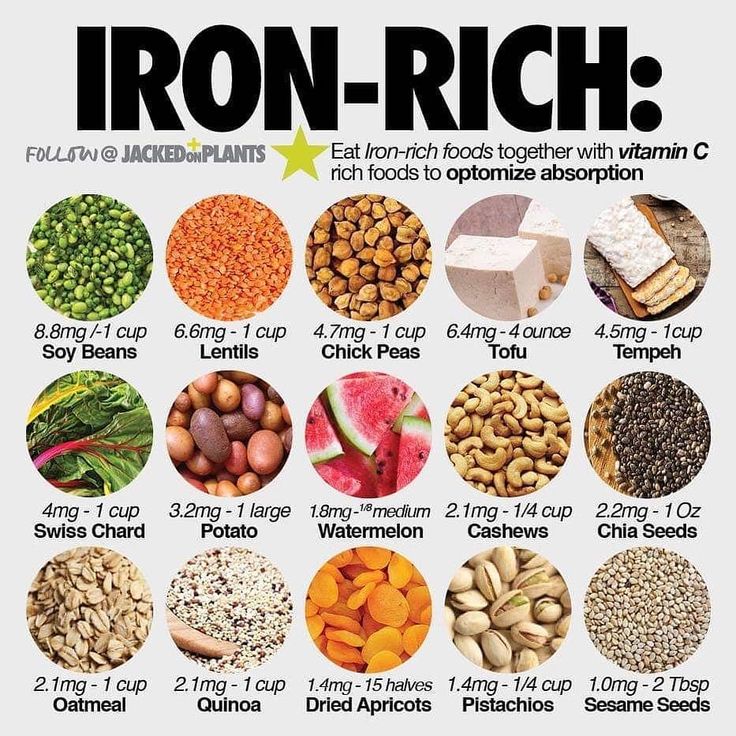 And heavenly food. Study the question to the end. There is a lot of literature on this subject. Vitamin synthetic supplements, of course, have absolutely nothing to do with it. Before arguing or condemning, it is necessary to have knowledge on the topic of interest. If they are not, then the dispute is absolutely groundless. The "all-eaters" side will always condemn the "diet" adherents. This is fine. A person must grow up, reach this himself. nine0016 References:
And heavenly food. Study the question to the end. There is a lot of literature on this subject. Vitamin synthetic supplements, of course, have absolutely nothing to do with it. Before arguing or condemning, it is necessary to have knowledge on the topic of interest. If they are not, then the dispute is absolutely groundless. The "all-eaters" side will always condemn the "diet" adherents. This is fine. A person must grow up, reach this himself. nine0016 References:
1. Izyum - Confessions of a raw foodist and a raw food mono-diet
2. Pavel Sebastyanovich "A new book about the raw food diet, or Why cows are predators"
3. Arshavir Ter-Ovanesov (Aterov) "Raw food, or a new world free from diseases , vices and poisons”
4. Alexander Chuprin “What is a raw food diet and how to become a raw foodist”.
5. A. Eret "Treatment with hunger and fruits", "Healing system of mucusless diet"
8. Zeeland "Live kitchen"
9. Victoria Butenko "12 steps to a raw food diet.
How to get rid of addiction to boiled food. 2014-04-11, 890
there are mothers who are not quite healthy in their heads, but the moderators will forgive me :) In general, this topic, in my opinion, is from a series of home births .. who is for, no arguments will help .. and who is against, they will never understand .. 2014-03-07, Neo_
Just please don't take the egg whites seriously. In no case! Read the relevant literature. nine0005
2014-03-08, linata
Total 4 reviews Read all reviews.
Share:
03/07/2014
Updated 07/22/2015
Vegan nutrition during pregnancy and childhood
Authors: Reed Mangels, PhD, RD Katie Kavangh-Prochaska, RD
Content
- The main needs during pregnancy
- calories
- Belts
- Docozohexaenoic acid (DHA - omega -3 fatty acid)
- Vitamin B12
- Calcium and vitamin D yod acid
- Vitamin D
- Vegan Toddler Nutrition Chart (1 to 3 years)
- Vegan Toddler Nutrition Chart (4 to 13 years)
Basic Pregnancy Needs
Pregnant women need extra calories, protein, vitamins, and minerals to support their baby's growth and changes in their own bodies.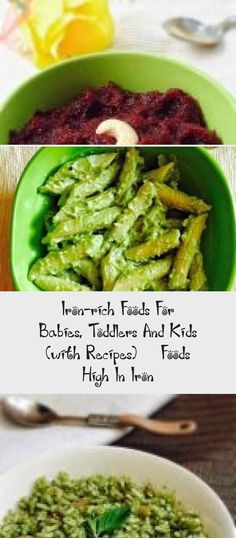 In addition to the calorie content of food, it is especially important to control the intake of sufficient amounts of proteins, docosahexaenoic acid (DHA), vitamin B12, iron, calcium, vitamin D, zinc, iodine and folic acid. nine0005
In addition to the calorie content of food, it is especially important to control the intake of sufficient amounts of proteins, docosahexaenoic acid (DHA), vitamin B12, iron, calcium, vitamin D, zinc, iodine and folic acid. nine0005
Calories
In the second trimester of pregnancy, an average of 340 additional calories should be consumed daily. In the third trimester, they need already 450 .. They are sent to support the growth of the child and changes in the woman's body. The number of calories needed may differ depending on the woman's pre-pregnancy weight, her activity level, and the weight she needs to gain. One way to get extra calories is to include nutritious snacks in your daily diet. nine0005
Proteins
During the second and third trimester of pregnancy, an additional 25 grams of protein is required. Adding another 25 grams to the average norm, we get that pregnant women need 71 grams of protein per day. Protein-rich plant foods include regular or fortified soy milk, tofu, tempeh, boiled beans, nuts, and nut butters.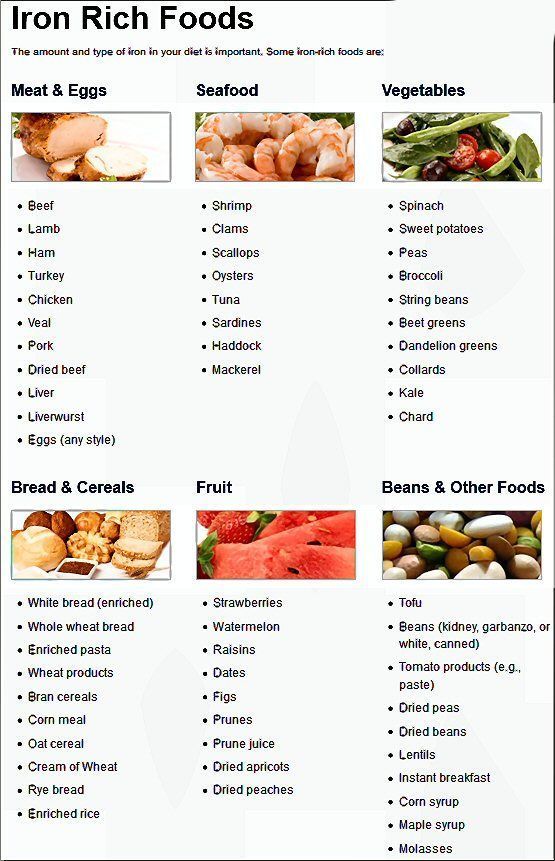 Eating a variety of plant foods will help pregnant women get the extra protein they need. nine0005
Eating a variety of plant foods will help pregnant women get the extra protein they need. nine0005
Docosahexaenoic acid (DHA - omega-3 fatty acid)
The fatty acid DHA is believed to play an important role in the development of the brain and eyes. Our body is able to convert some of the alpha-linolenic acid (ALA) into DHA. ALA is a type of fatty acid found in flax seeds, flaxseed oil, canola oil, walnuts, and soy. However, due to our body's inability to convert ALA into DHA efficiently, pregnant women are advised to take an algae-based DHA vitamin supplement. nine0005
Vitamin B12
Vitamin B12 is essential for the development of the nervous system of the fetus, and therefore during pregnancy it is necessary to increase its intake. Good sources of vitamin B12 include foods fortified with it, such as soy milk, vegetarian meat substitutes, breakfast cereals, and nutritional yeast. One tablespoon of Red Star Vegetarian Support Formula nutritional yeast contains enough vitamin B12 to meet a pregnant woman's daily requirement of vitamin B12 for a pregnant woman. It is extremely important for pregnant women to consume this vitamin. Therefore, if their diet does not contain the above foods, then they need to use prenatal vitamins containing vitamin B12. nine0005
It is extremely important for pregnant women to consume this vitamin. Therefore, if their diet does not contain the above foods, then they need to use prenatal vitamins containing vitamin B12. nine0005
Iron
Pregnant women need to consume more iron due to increased blood volume in the body, as well as for the formation of fetal blood. Iron deficiency anemia is an actual problem of pregnant women, regardless of their dietary style. All pregnant women need to consume iron-rich foods such as leafy greens, beans, lentils, peas, tofu, and whole grains.
Calcium and vitamin D
Calcium and vitamin D work together to form bones and teeth. During pregnancy, the body absorbs calcium better than usual, which helps to meet the increased need for this mineral. Pregnant women should consume at least eight servings of calcium-rich foods daily. These include leafy greens and calcium-fortified tofu, soy milk, and orange juice. In addition, you can consume calcium in the form of vitamins, especially on days when there is no appetite.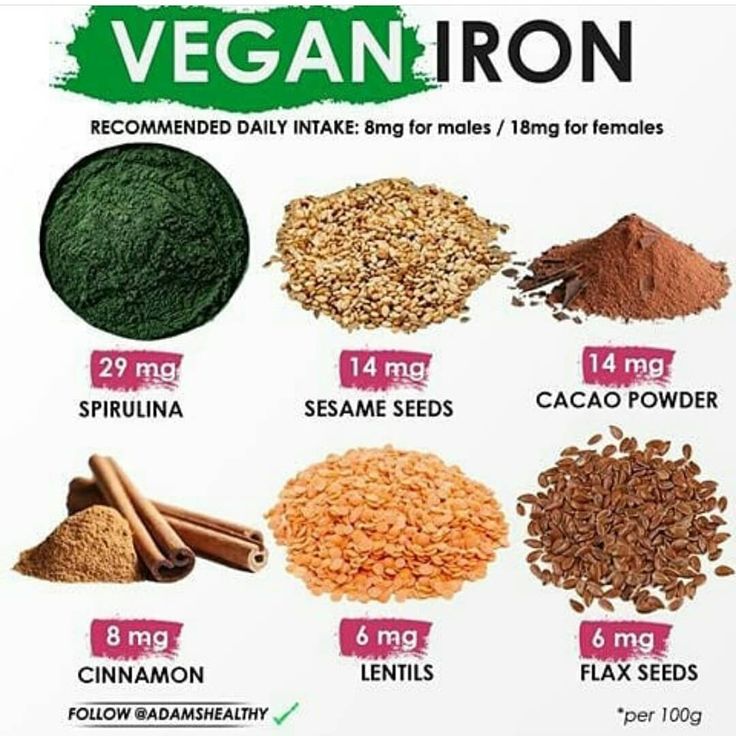 Vitamin D is found in fortified soy milk and fortified breakfast cereals. nine0005
Vitamin D is found in fortified soy milk and fortified breakfast cereals. nine0005
Zinc
Zinc is essential for growth and development. During pregnancy, women need more zinc. Good sources of zinc include peas, beans, fortified breakfast cereals, nuts, seeds, wheat germ, tofu, and tempeh.
Iodine
Pregnant women need to use iodized salt to meet their iodine needs. Just over half a teaspoon of iodized salt meets the daily requirement of a pregnant woman. Iodine is included in some prenatal vitamins, and if the label indicates that they contain 100% of the recommended daily intake, then you do not need to take additional iodine. nine0005
Folic acid
Getting enough folic acid is important even before a woman knows she is pregnant. Therefore, all women of childbearing age should consume at least 400 micrograms of folic acid daily from vitamins or fortified foods. During pregnancy, the need for folic acid increases to 600 micrograms. Leafy greens, whole grains, and orange juice are good sources of folic acid.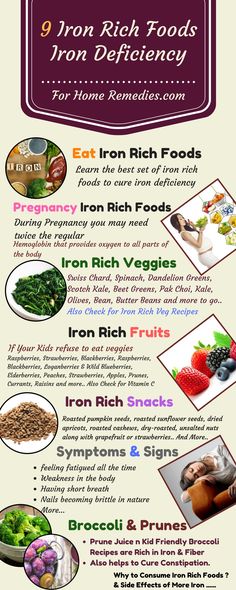 Vegan diets are often high in folic acid. nine0005
Vegan diets are often high in folic acid. nine0005
Basic needs during breastfeeding
Optimal nutrition for breastfeeding mothers is similar to the diet recommended for pregnant women. Protein intake requirements remain the same, vitamin B12 requirements are higher, and total calories and iron intake are lower. It's also important to make sure you're getting enough vitamin D, calcium, iodine, and DHA. In addition to good nutrition, women should take prenatal vitamins shortly before, during, and after pregnancy. nine0005
Basic needs for infants (0-12 months)
Breast milk is the ideal food for a baby in the first year of life. Breast milk strengthens the baby's immune system, protects it from infections and reduces the risk of allergic reactions. The benefits of breastfeeding for the mother include the convenience of breastfeeding, reduced risk of breast cancer before menopause, and increased release of stress-reducing hormones. Breastfeeding can also help women lose weight. However, they should not limit their calorie intake at the same time they are trying to get their milk production going. There may be other benefits of breastfeeding that we don't know about yet. nine0005
However, they should not limit their calorie intake at the same time they are trying to get their milk production going. There may be other benefits of breastfeeding that we don't know about yet. nine0005
Vitamin D
The surest way to meet your vitamin D needs is to consume vitamins or fortified foods. Vitamin D is produced by our skin when exposed to sunlight. If sunscreen is applied to the skin, the amount of vitamin D produced is significantly reduced. Due to the fact that people are advised to use sunblock when they go out in the sun, it becomes necessary to take vitamins or eat fortified foods. To prevent vitamin D deficiency, the American Academy of Pediatrics recommends giving 400 IU of vitamin D daily a few days after the baby is born. Vitamin D is found in sufficient amounts in baby food. Therefore, formula-fed babies do not need to take vitamin D separately. If a child develops a vitamin D deficiency, it can lead to the development of rickets (softening of the bones). nine0005
nine0005
Iron
Breastfed babies should start being given vitamins or iron-fortified foods (such as baby porridge) at four to six months of age. Formula-fed babies likely won't need additional vitamins with iron, as iron is found in infant formula. If you are considering giving your child vitamins with iron, check with your pediatrician to determine the correct dose.
Soy based infant formula
In the event that vegan parents decide that breastfeeding is not possible in their situation, they can use soy-based infant formula. Because some types of soy formula contain animal fats, it's important to check labels for ingredients. Unfortunately, as of this writing, there is no soy-based infant formula in the US that does not contain lanolin [vitamin D3], an animal wax derived from sheep's wool. There are currently no other alternatives for vegan children. The situation will change only when consumers begin to demand alternative products. nine0005
It is important to note that soy milk, rice milk and homemade baby food are not a complete substitute for commercially produced infant formula for infants.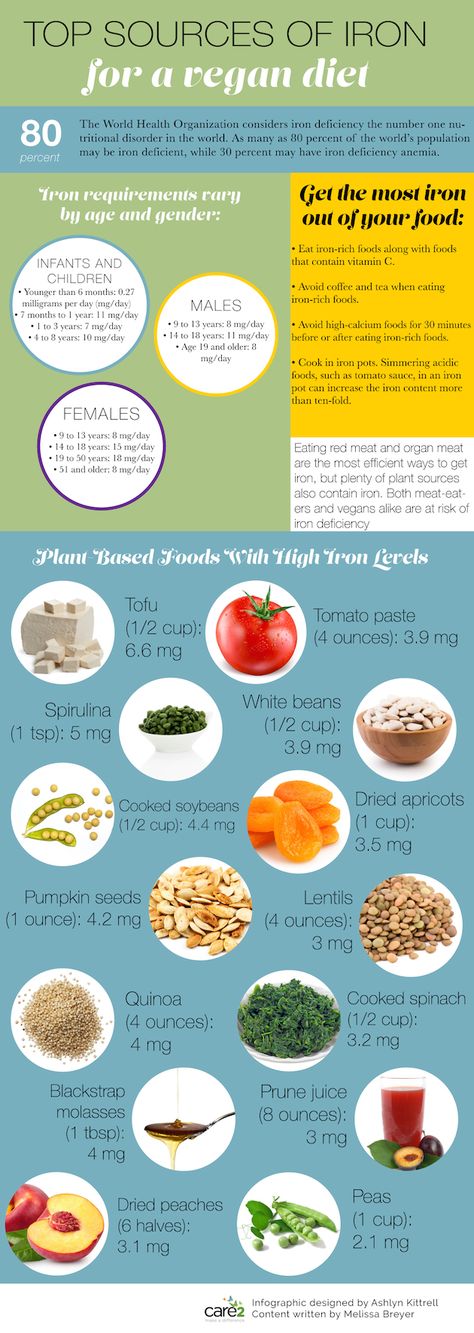 Such food does not contain all the nutrients necessary for the development of infants.
Such food does not contain all the nutrients necessary for the development of infants.
Complementary foods
Most infants are ready to eat thicker foods between the fourth and sixth month of their lives. Try to gradually introduce one new ingredient into your diet, observing the reaction of the body for two to three days. This will help identify the allergen if the child develops an allergy. nine0005
You can start complementary foods with baby rice porridge enriched with iron. It is an excellent source of iron and is unlikely to cause an allergic reaction if consumed. After the child has become good at coping with this porridge, you can try giving him other porridges, such as oatmeal, pearl barley and corn. Then you can start adding vegetables to your diet. Just like with other foods, they need to be tasted one at a time in order to follow the reaction of the child's body. Before serving vegetables, they need to be thoroughly kneaded or rubbed through a strainer.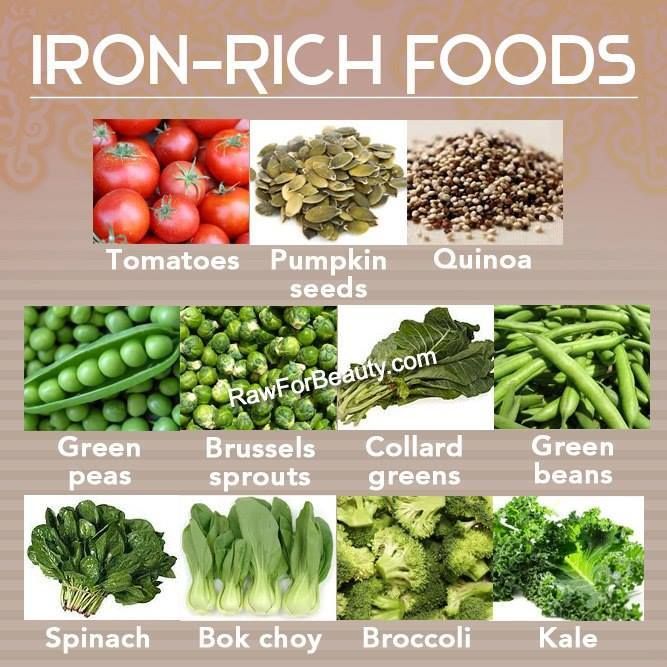 For example, you can start with vegetables like carrots, sweet potatoes, and green beans. nine0005
For example, you can start with vegetables like carrots, sweet potatoes, and green beans. nine0005
Fruit is usually given after the child has tasted the vegetables. This is done so that the child gets used to the taste of vegetables before he experiences the sweeter taste of fruit. You can start with mashed bananas, pears or peaches.
Protein foods are usually given to children between the ages of seven and ten months. Good sources of protein are mashed boiled beans, mashed tofu, and soy yogurt. Nut and seed-based spreads spread on bread or crackers can be given after the child is one year old. nine0005
Some parents rely primarily on store-bought baby food. Today, there are different types of food suitable for vegetarian children. However, it is important to read the ingredients to make sure the food is vegetarian. Many parents would like to cook their own baby food. In this case, it must be taken into account that you need to cook without adding sugar, salt or spices.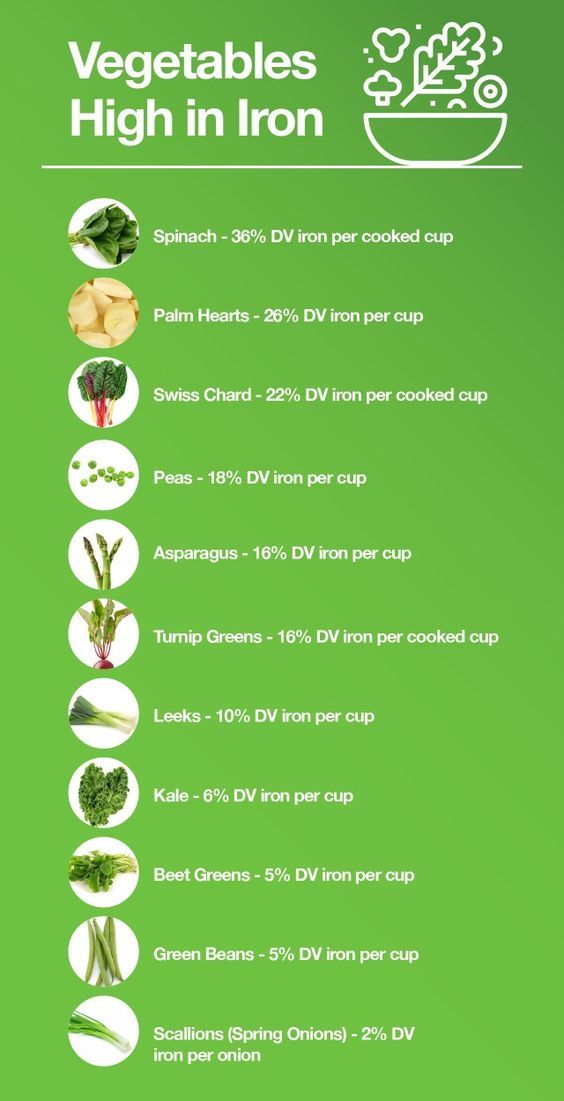 You should also remember about the observance of sanitary standards in the kitchen. Food must be brought to full readiness, then pureed or rubbed through a strainer. nine0005
You should also remember about the observance of sanitary standards in the kitchen. Food must be brought to full readiness, then pureed or rubbed through a strainer. nine0005
Compared to other periods of their lives, children under two years of age need more calories and fat. Fats play a particularly important role in brain development. Mashed avocados, vegetable oil, nut butters, and seed-based butters spread on crackers (for children over one year old) can be added to the baby's diet to increase the fat intake in a child's diet.
If a nursing mother does not have a reliable source of vitamin B12 in her diet, then this vitamin must be given directly to the baby. nine0005
Vegan food for toddlers and preschoolers
Children, especially toddlers and preschoolers, usually eat less than their parents would like. This comes from the fact that the child develops a sense of independence and from the fact that growth slows down. All parents should take their child to the pediatrician for regular checkups to monitor growth, development and health changes.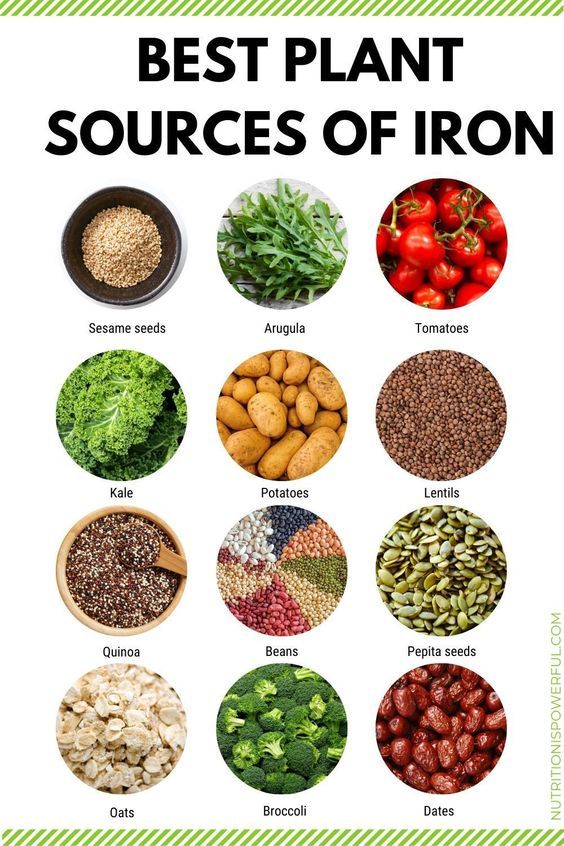 Parents also need to make sure that the food their child consumes provides him with all the necessary nutrients. The preschool years are a time when a child can develop healthy eating habits, which in turn can help them stick to a healthy diet as an adult. nine0005
Parents also need to make sure that the food their child consumes provides him with all the necessary nutrients. The preschool years are a time when a child can develop healthy eating habits, which in turn can help them stick to a healthy diet as an adult. nine0005
Calories and fats
Young children have small stomachs, so eating high-fiber foods can interfere with your child's energy needs. Diets rich in fresh vegetables, fruits, and whole grains are usually also high in fiber. The amount of fiber a child consumes can be reduced by adding processed cereals, fruit juices, and peeled fruits and vegetables to the diet. Since a small amount of foods such as avocados, nut butters, dried fruits and soy products contain a lot of calories, they are ideal for a growing body. In order to promote the synthesis of DHA, an important type of fat, sources of alpha-linolenic acid, such as rapeseed oil, linseed oil, and soy products, should be included in the child's diet. nine0005
Proteins
The child will be able to meet his need for proteins by eating a variety of foods and a sufficient number of calories. There is no need, as previously thought, to precisely plan and match amino acids with each meal. Enough to give the child a few main meals and snacks throughout the day. Variety is key to building a healthy diet. Protein is found in legumes, grains, vegetarian meat substitutes, nut butters, and soy products. nine0005
There is no need, as previously thought, to precisely plan and match amino acids with each meal. Enough to give the child a few main meals and snacks throughout the day. Variety is key to building a healthy diet. Protein is found in legumes, grains, vegetarian meat substitutes, nut butters, and soy products. nine0005
Calcium
Calcium plays an important role in building bones and teeth. Good sources of this mineral include calcium-fortified soy milk, rice milk, orange juice, tofu, as well as molasses, beans, and textured soy protein. Do not rely on leafy greens as one of the main sources of calcium - the child's stomach will not contain the amount of leafy greens that is needed to obtain a daily allowance. However, older children can eat enough brauncol, collard greens, turnip greens, mustard greens, and other calcium-rich foods to meet their calcium needs. nine0005
Zinc
At the moment, there is no data on the content of zinc in the diet of vegan children. Good sources of zinc include legumes, whole grain flour products, wheat germ, fortified breakfast cereals, tofu, nut butters, and miso.
Vitamin D
Dietary sources of vitamin D include fortified soy and rice milks and some types of breakfast cereals. Children who do not eat foods fortified with vitamin D need to take vitamin supplements. Previously, people were advised to spend more time in the sun in order to meet their need for vitamin D. Current recommendations call for the use of sunscreen to protect the skin from the negative effects of sun exposure. Since sunscreen interferes with the production of vitamin D, you should not rely solely on the sun's rays to provide your body with the necessary amount of this vitamin. nine0005
Vitamin B12
Vegan children need to consume either foods fortified with vitamin B12 or vitamin supplements containing B12. There are a variety of foods fortified with vitamin B12, such as certain types of soy milk, vegetarian meat substitutes, nutritional yeast, and breakfast cereals.
Iron
Iron deficiency anemia is common in children regardless of their type of diet.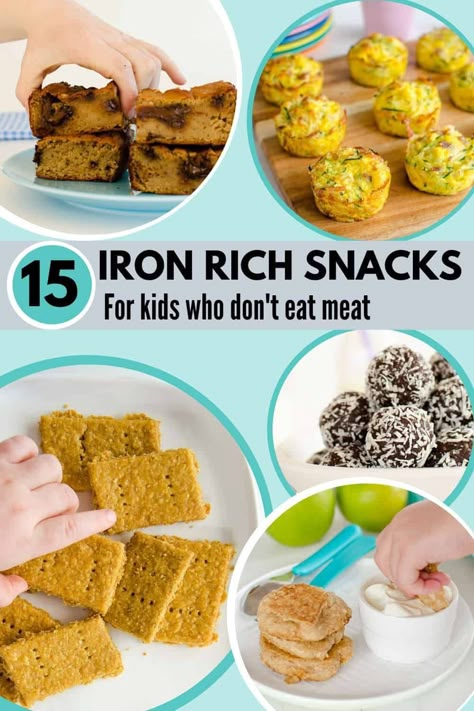 Good sources of iron include legumes, leafy greens, dried fruits, iron-fortified breakfast cereals, and foods made with whole grain or fortified white flour. Vitamin C promotes the absorption of iron, so it is recommended to give citrus fruits to the child along with iron-containing foods. nine0005
Good sources of iron include legumes, leafy greens, dried fruits, iron-fortified breakfast cereals, and foods made with whole grain or fortified white flour. Vitamin C promotes the absorption of iron, so it is recommended to give citrus fruits to the child along with iron-containing foods. nine0005
Food that a child might choke on
At toddler age, children actively learn to chew and swallow. They do not yet have a full set of teeth, and they do not have time to chew food properly, because they are in a hurry to swallow it. Therefore, they can choke on food quite easily. To minimize the likelihood of such a situation, pay attention to the list of products below. They are best avoided or only given to a child under close supervision:
- Nuts. Nuts can only be served in crushed form.
- Nut pastes and hummus (with spoons, without anything).
- Nut pastes or hummus spread on bread.
- Whole vegetarian sausages. They should be cut into pea-sized pieces.

- Cherry tomatoes. They should be cut in half or quarters.
- Grape. Each berry must be cut in half. For young children, the grapes may need to be skinned. nine0025
- Cherries and cherries. Before serving, they must be cleaned of stones and cut into pieces.
- Raw celery and whole carrots
- Popcorn
Cooking tips for children
Among vegan children, especially popular are:
- Pizza without cheese and with vegetables, tofu or vegetarian meat substitutes
- Pasta with tomato sauce
- Baked potatoes
- Soy yogurt
- Milkshakes made with calcium fortified soy milk with fruits
- Bread spread with peanut butter and jam
- Fresh or dried fruit
- Fritters, pancakes and waffles
- Raw vegetables with dipping sauce
- Buns (muffins) nine0024 Mashed potatoes
General tips
- Use a cast iron skillet to cook acidic foods like tomato sauce.
 This helps to increase the iron content of the cooked dish.
This helps to increase the iron content of the cooked dish. - Use plant-based milk fortified with vitamin D, B12 and calcium
- Include foods rich in zinc in your child's diet. These include peas, beans, brown rice, nuts, spinach, tofu, wheat germ, fortified breakfast cereals, and tempeh. nine0025
- Let your child try one food at a time so that an allergy to one or another of these products can be easily identified
- Do not limit your child's fat intake until he is two years old. Fat is essential for brain development. Good vegetable sources of fats include avocados, olive oil, and nut butters.
- Most meals such as pancakes and buns can be made vegan
Nutrition chart for vegan infants (4 to 12 months)
| Chart 1. Nutrition for vegan infants (4 to 12 months) | ||||
| Breast milk | Breast milk or soy infant formula. | Breast milk or soy infant formula. | Breast milk or soy infant formula.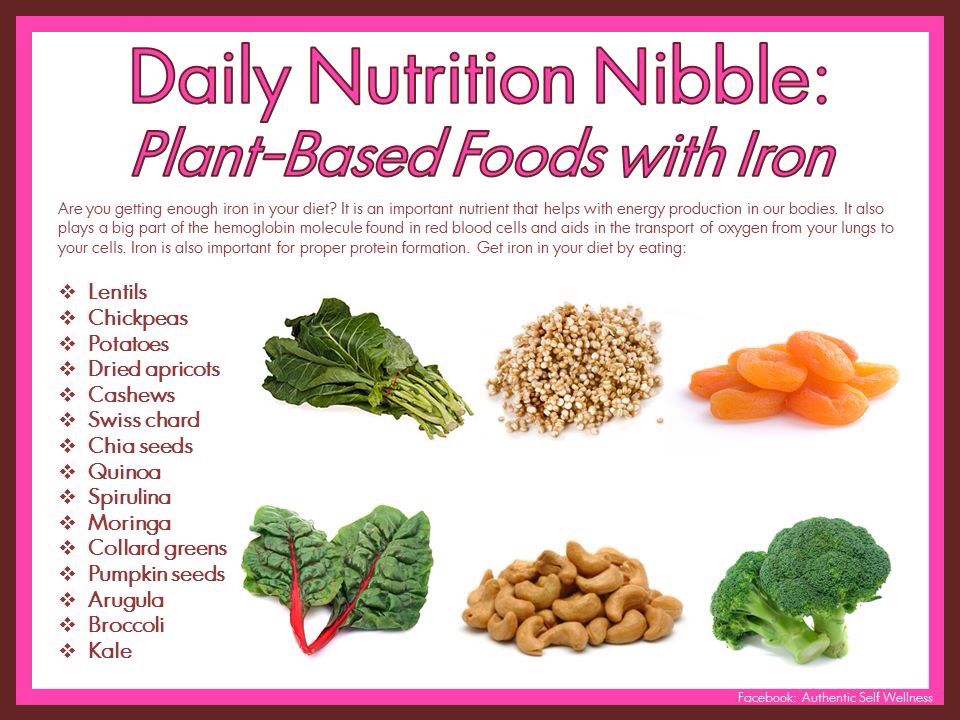 | Breast milk or soy infant formula (700-900 ml). |
| Cereals and bread | Start giving iron-fortified baby porridge with milk. | Baby porridge. Start giving other types of porridge and bread. | Children's porridge and other types of porridge and bread. | Give a total of 4 servings of cereals and bread throughout the day (1 serving = 1/4 slice of bread or 2-4 tablespoons of cereal). |
| Fruits and vegetables | - | Introduce fruit juices (50-120 ml) for vitamin C into the diet and begin to give fruits and vegetables mashed through a strainer. nine0371 | 120 ml juice. Pieces of soft fruits and vegetables. | Let's have regular food. 4 servings a day (1 serving = 2-4 tbsp fruits and vegetables or 120 ml juice) |
| Bean and nut butters | - | - | Slowly introduce tofu, baked goods, bean puree and soy yogurt. | Two servings of 15 g each day. Nut butters should not be given until the child is one year old. Nut butters should not be given until the child is one year old. |
| *Partial coincidence of ages takes into account the different speed of development of children | ||||
Vegan Toddler Nutrition Chart (1 to 3 years)
| Vegan Toddler Nutrition Chart (1 to 3 years) | |
| Cereals | 6 servings or more. One serving is 1/2 - 1 slice of bread; 1/4 - 1/2 cup boiled porridge, cereal or pasta; 1/2 - 3/4 cup corn flakes or other type of breakfast cereal. |
| Legumes, nuts, seeds | 2 or more servings. One serving is 1/4 to 1/2 cup boiled beans, tofu, tempeh, or textured soy protein; 40 - 85 g of vegetarian meat substitutes; 1 - 2 tbsp. nuts, seeds or nut pastes or seed-based pastes. |
| Fortified soy milk, etc. | 3 servings. One serving is 1 cup of fortified soy milk, soy infant formula, or breast milk. |
| Vegetables | 2 or more servings. One serving is 1/4 - 1/2 cup cooked or 1/2 - 1 cup raw vegetables. |
| Fruit | 3 or more servings. One serving is 1/4 - 1/2 cup canned fruit, 1/2 cup juice, or 1 medium sized fruit. |
| Fats | 3 servings. One serving is 1 tsp. vegetable oil. (Use 1/2 teaspoon flaxseed oil or 2 teaspoons canola oil to ensure your intake of omega-3 fatty acids.) |
Nutrition Chart for Vegan Children (ages 4-13)
| Chart 3. Nutrition for Vegan Children (ages 4-13) | |
| Cereals | 8 or more for children 4-8; 10 or more for children aged 9 to 13. One serving is 1 slice of bread; 1/2 cup boiled porridge, cereal or pasta; 3/4 cup corn flakes or other type of breakfast cereal. |
| Protein products | 5 or more for children 4-8; 6 or more for children aged 9 to 13.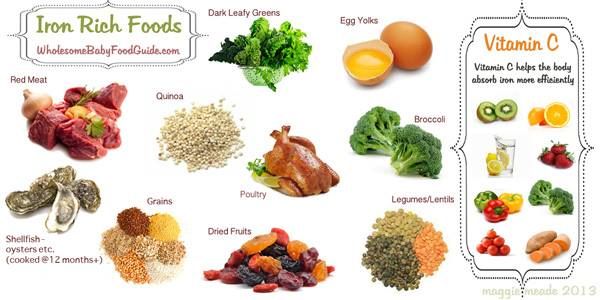 One serving is 1/2 cup boiled beans, tofu*, tempeh, or textured soy protein; 1 cup fortified soy milk*; 30 g of vegetarian meat substitutes; 1/4 cup nuts or seeds*; 2 tbsp nut butter or seed-based butter*. One serving is 1/2 cup boiled beans, tofu*, tempeh, or textured soy protein; 1 cup fortified soy milk*; 30 g of vegetarian meat substitutes; 1/4 cup nuts or seeds*; 2 tbsp nut butter or seed-based butter*. |
| Vegetables | 4 or more servings. One serving is 1/2 cup cooked or 1/2 cup raw vegetables*. | nine0372
| Fruit | 2 or more servings. One serving is 1/2 cup canned fruit, ? glass of juice* or one medium-sized fruit. |
| Fats | 2 or more for children 4-8 years; 3 or more for children aged 9 to 13. One serving is 1 tsp. vegetable oil. |
| Omega-3 fatty acids | 1 serving per day. One serving is 1 tsp. linseed oil, 1 tbsp. rapeseed or soybean oil, 1 tbsp. ground flax seeds or 1/4 cup walnuts nine0371 |
| Starred (sources of calcium) | 6 or more for children 4-8 years; 10 or more for children aged 9 to 13. One serving is 1/2 cup tofu cooked with calcium; 1 cup fortified soy milk, orange juice, or soy yogurt 1/4 cup almonds; 2 tbsp sesame paste (tahini) or almond paste; 1 st. cooked or 1 cup raw broccoli, bok choy, collard, browncol, or mustard greens. cooked or 1 cup raw broccoli, bok choy, collard, browncol, or mustard greens. | nine0372
Notes:
Products that are marked with an asterisk also count in the groups listed above in the table. They do not need to be used additionally. However, it is important to make sure your child is eating enough servings of these foods to meet their calcium needs. The size of one serving may vary depending on the age of the child.
You can increase your calorie intake by adding more nut butters, dried fruits, soy products, and other high-calorie foods to your diet. nine0005
Regular vitamin B12 intake should be taken in the form of vitamin supplements or fortified foods such as Red Star Vegetarian Support Formula nutritional yeast, soy milk, breakfast cereals, and vegetarian meat substitutes.
To meet the need for vitamin D, you need to spend 2-3 times a week in the sun for 20 to 30 minutes with an open face and hands. If this is not possible, it is necessary to drink vitamin D in the form of vitamin supplements.